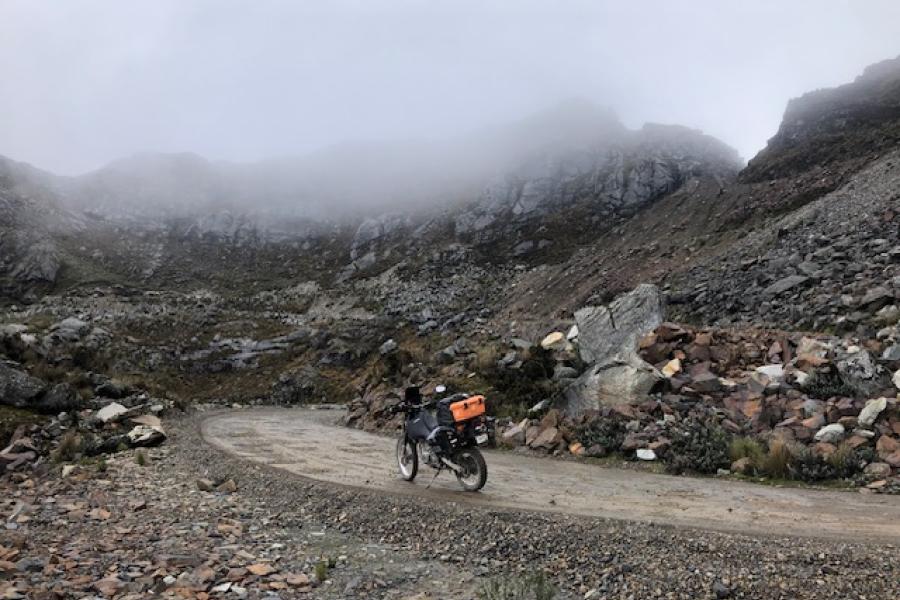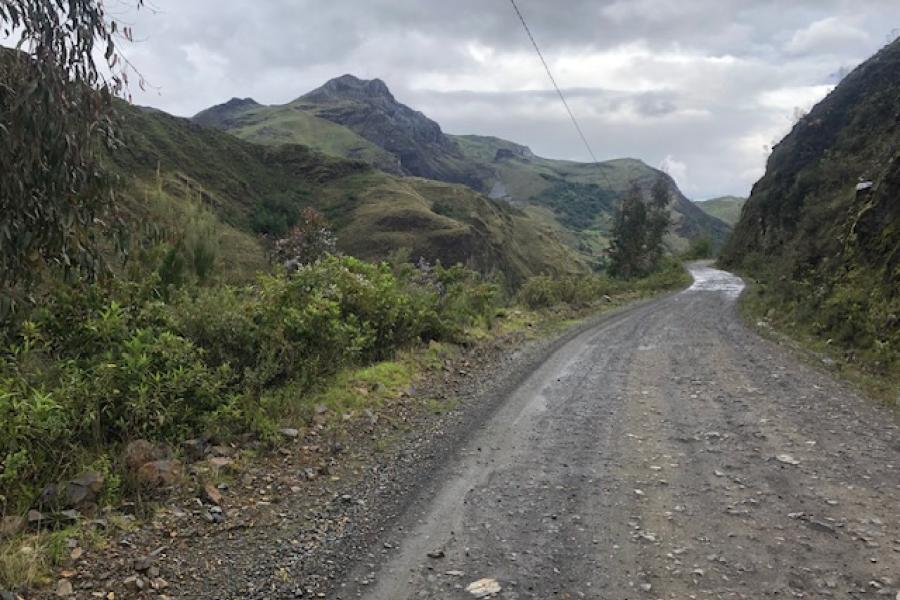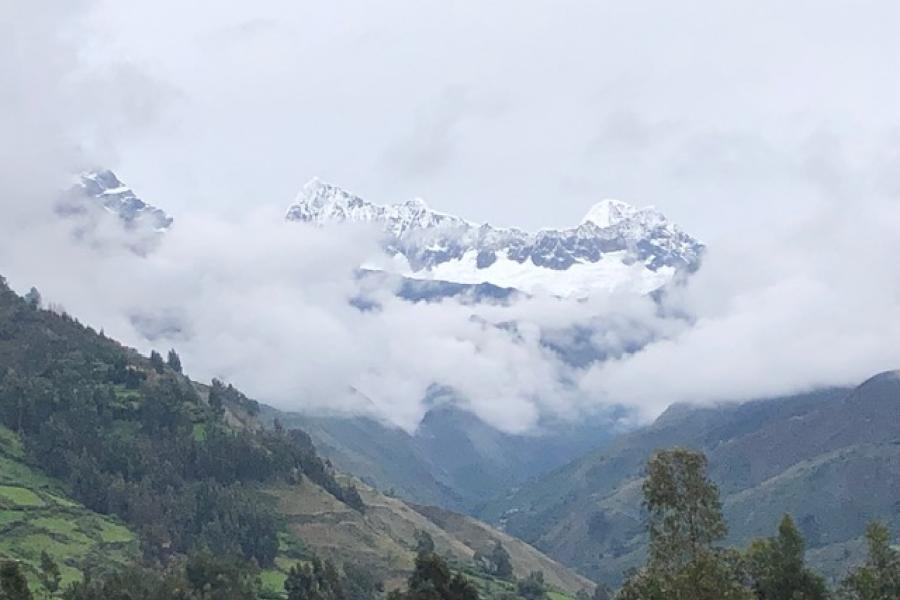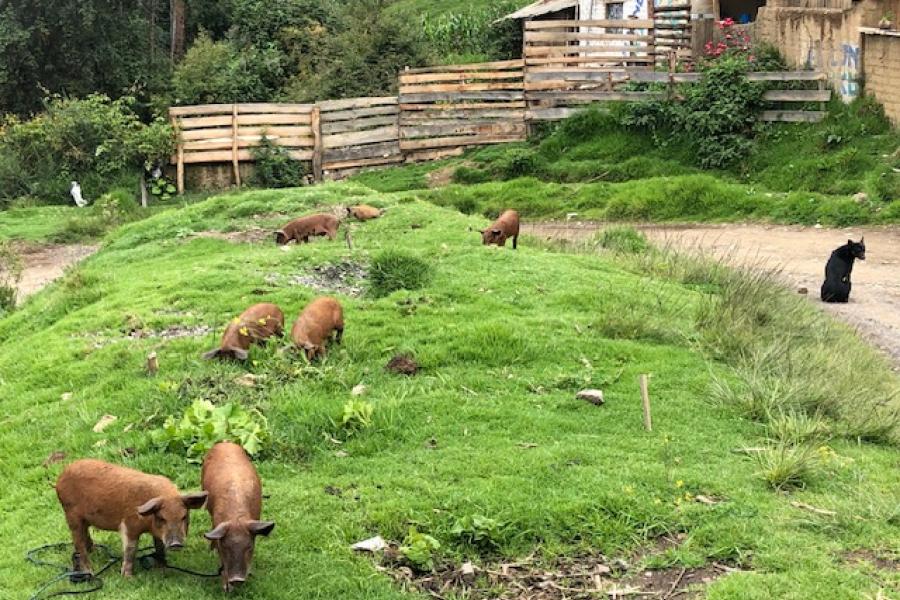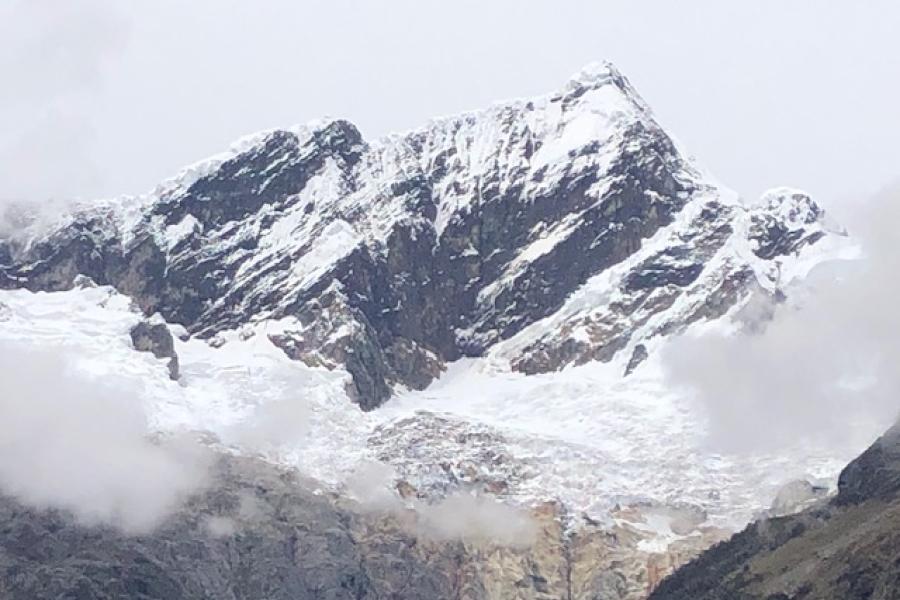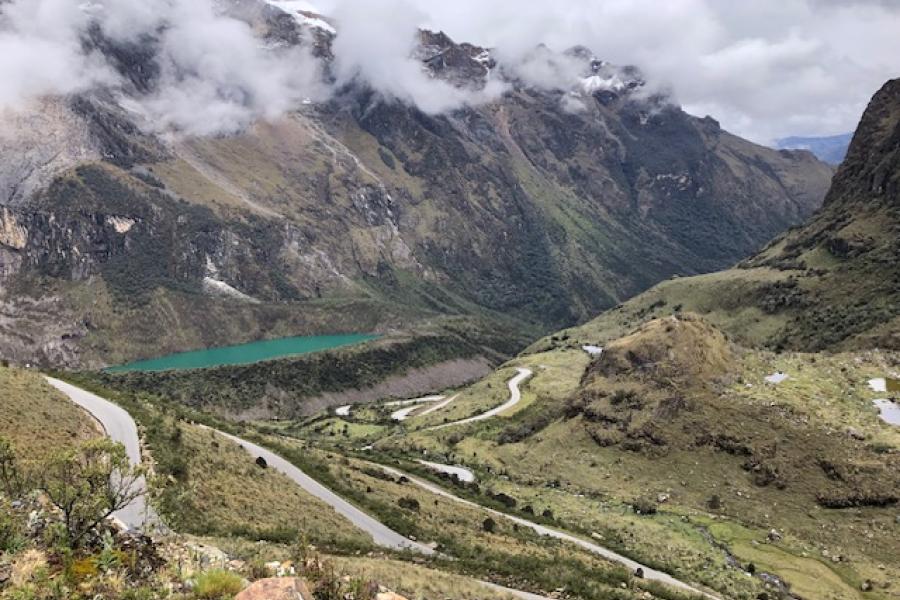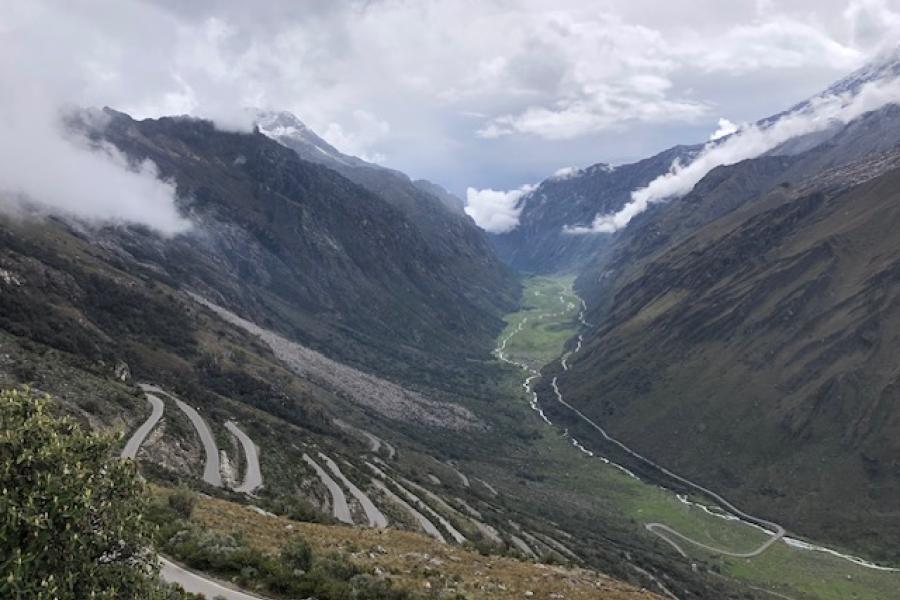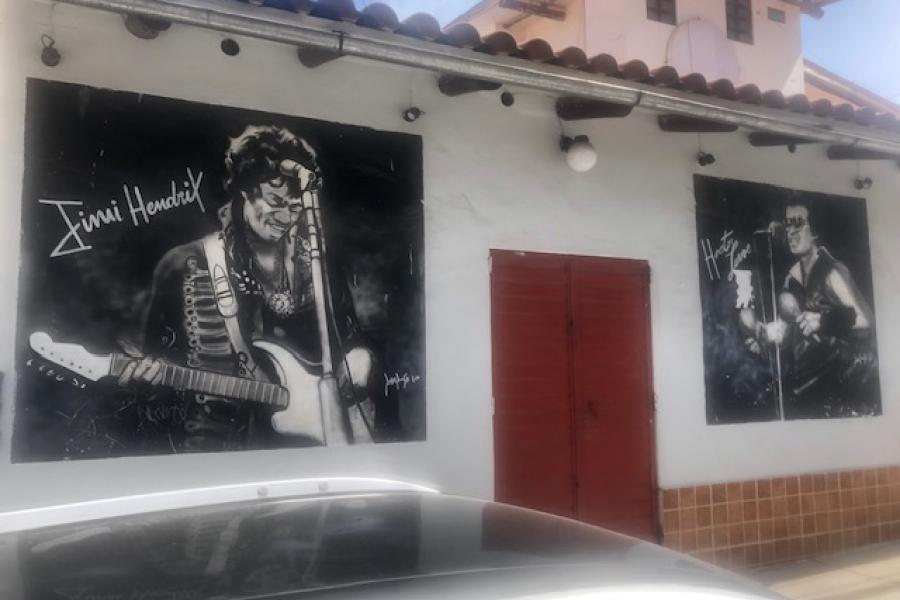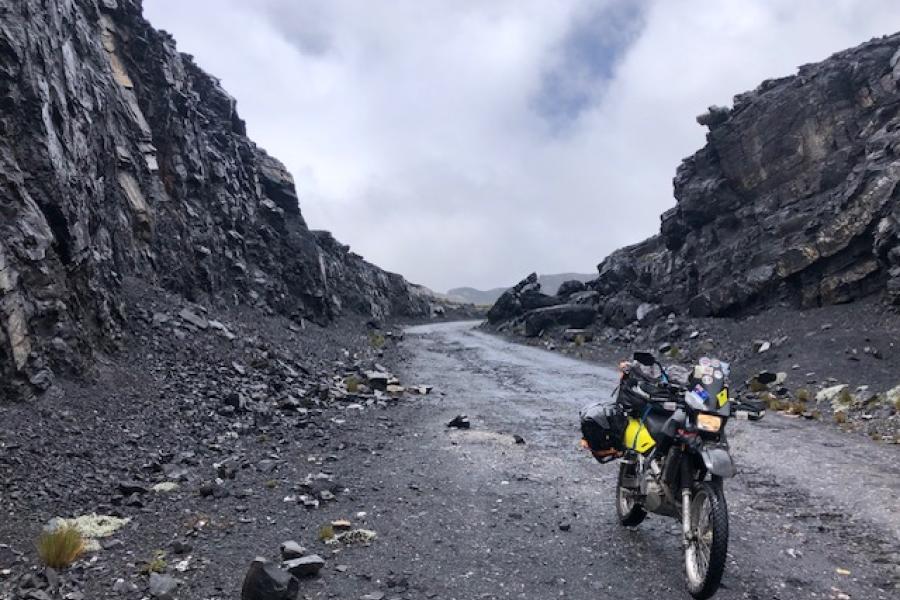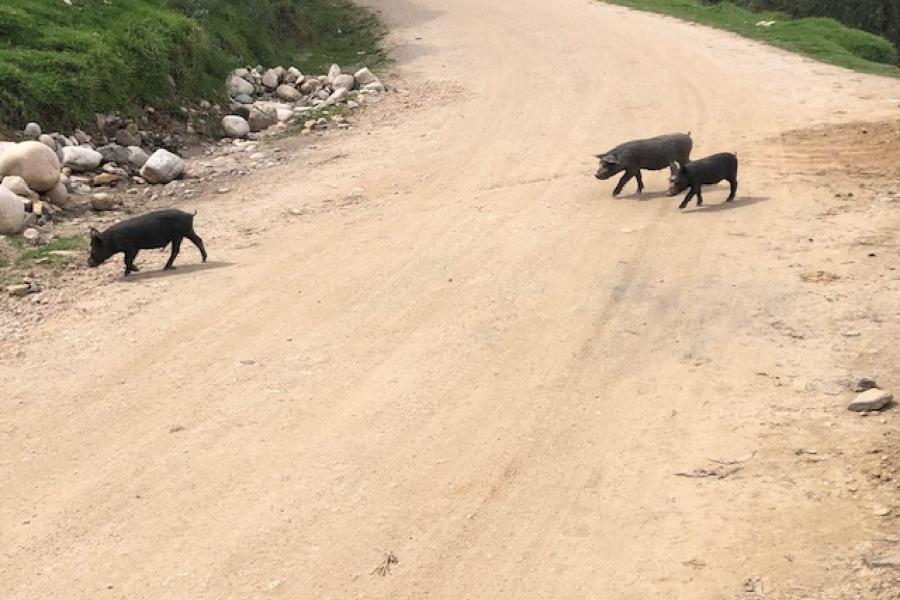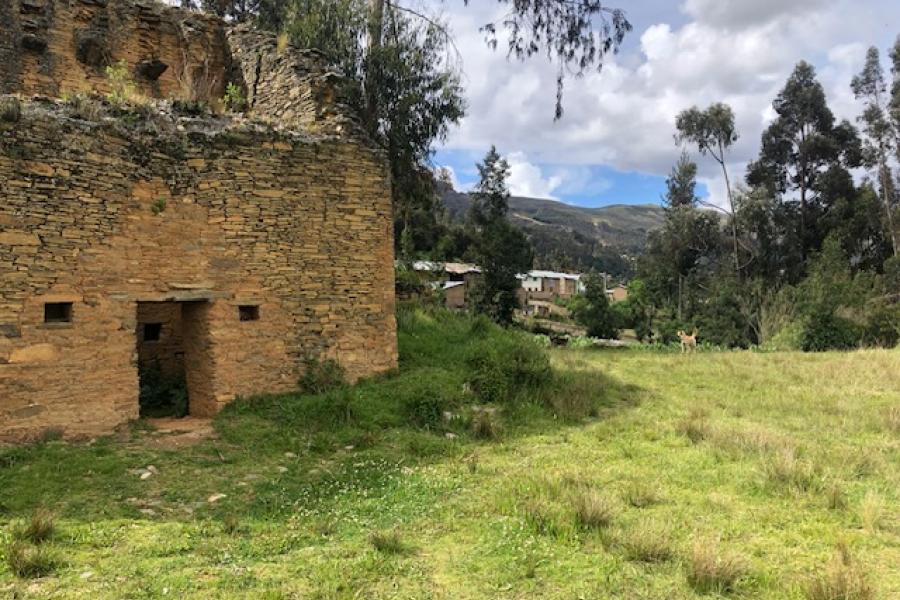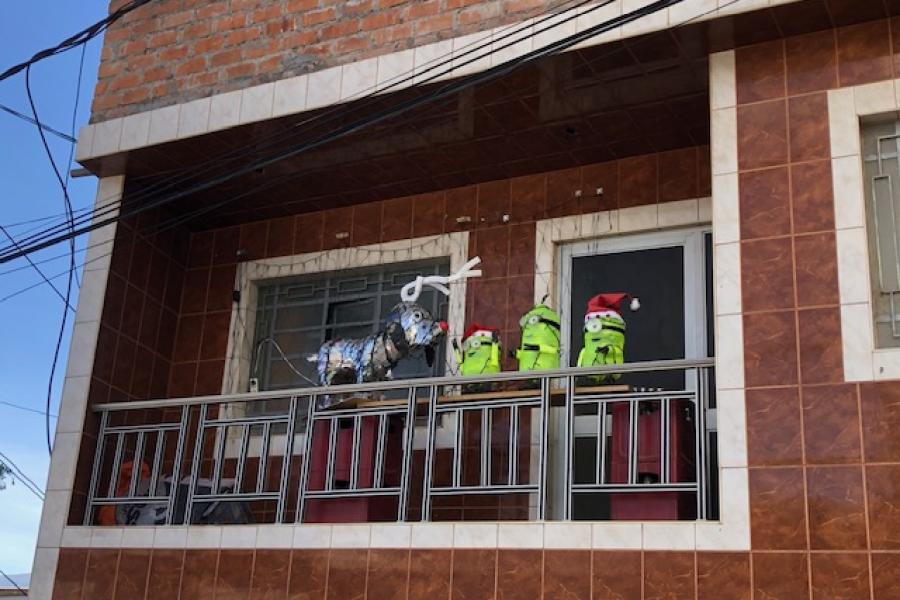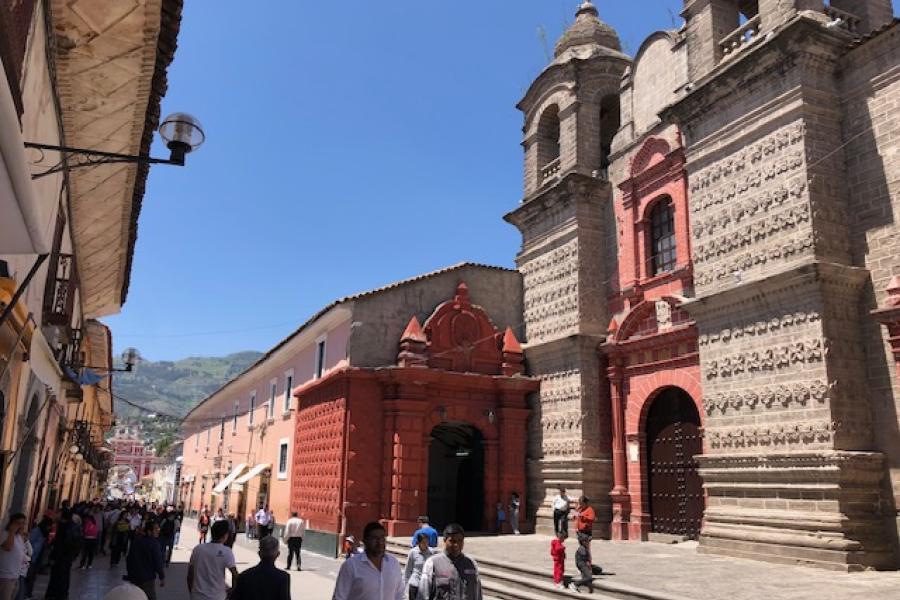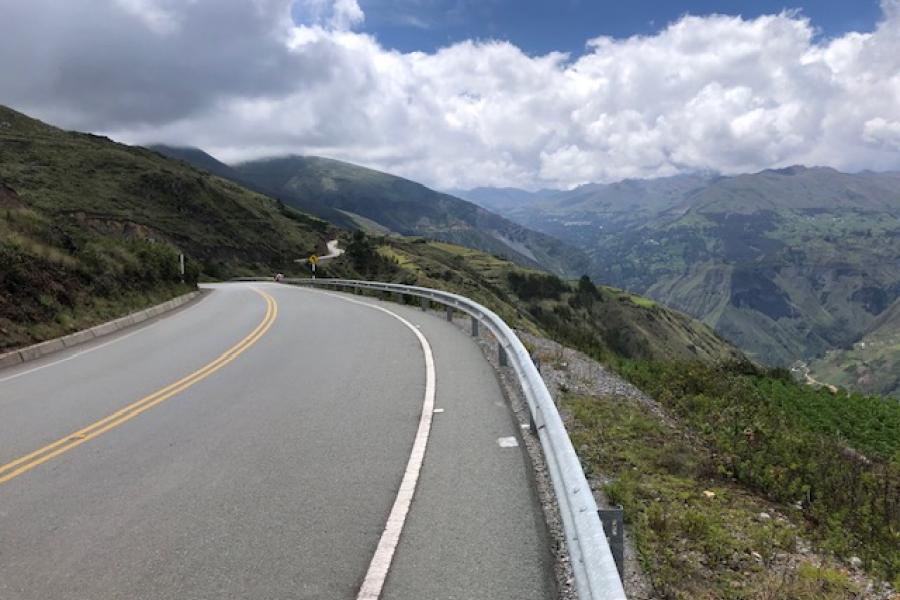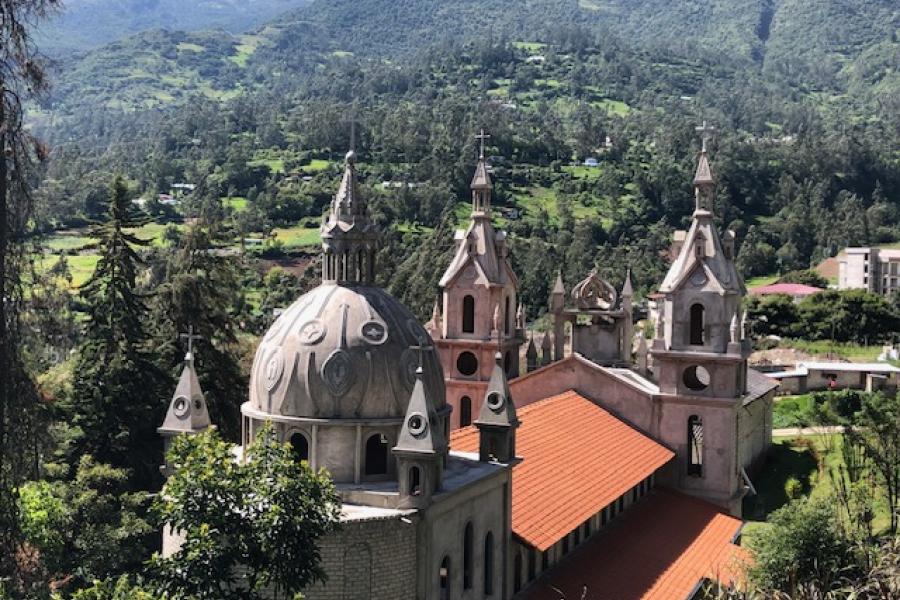Peru, Caraz → Cachora
Country
The bike got a birthday before being handed over to the mechanic. It's had a few paid pressure washes along the way, but none by hand since Durango. I must do this more often - it's always a good chance to see what's broken, missing, bent or loose.
Albert's workshop was typical of these parts - right beside a main road, so lots of dust, busy with folk coming and going, discarded bikes and tyres.
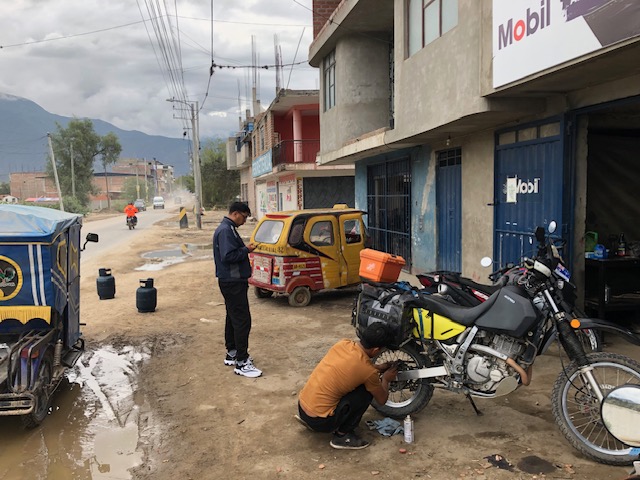
While it had a solid backyard vibe, it had come recommended and rightly so. Mechanic Richard changed the rear and steering head bearings far quicker than I would, using rudimentary tools.
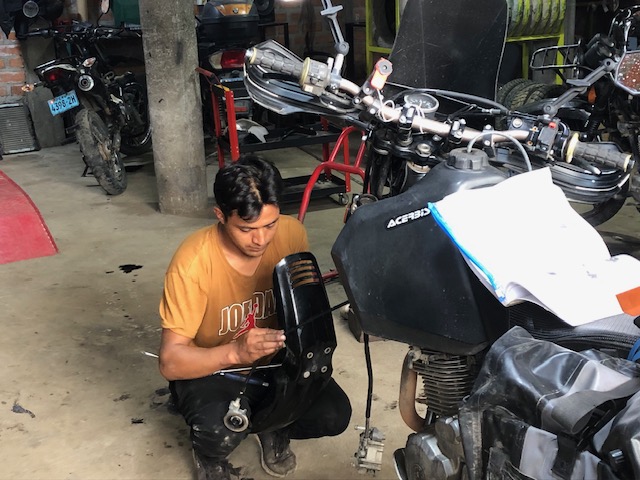
At home I would have farted around welding a bead to shrink the old shells, putting the new shells in the freezer, heating up the wheel bores, drifting them in with a correct sized socket, or even in a press, blah blah blah. Not so much here. A few well aimed blows with the Big Fn Hammer did the job. No torque wrenches in sight, just a finely calibrated wrist.
For sure the steering bearings were stuffed. Not only were the shells notched to buggery, there were signs of water ingress.
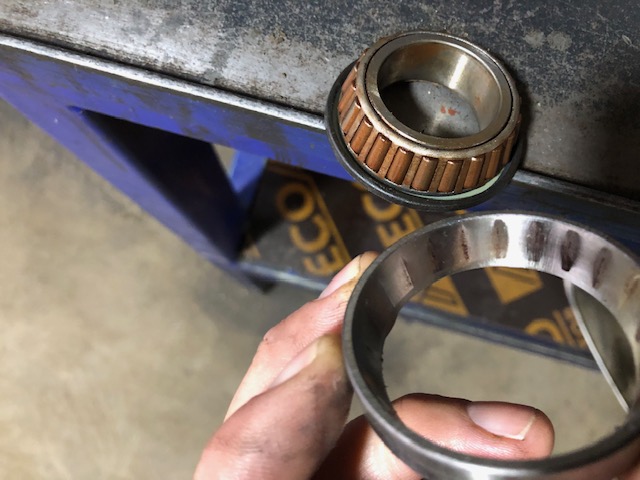
Post repair Albert the boss man took it for a squirt. With his typical Peruvian stature, he could hardly get his leg over. Upon return he directed Richard to:
• deglaze the rear pads & disc (fair call, they'd been squealing)
• lube & adjust the clutch cable (yep, was pretty crappy)
• lube the side & centre stands (right again)
and pointed out that the shocker was too soft, on the way out (correct)
Richard also went for a fang. He found a big smile somewhere around the block; I guess this was a bit bigger than the bikes he'd normally deal with.
Another amusing money moment: The total bill for the three rear bearings and a few hours of Richard (105 soles, $35 AUD) was a third of the cost of the two steering bearings from the big city. I gave Richard twenty soles for being a good sport, letting me watch over and occasionally get in the way. His big smile returned.
A few blasts uphill on the main street in high gear couldn't provoke any more clutch slip. Cough ... ahem ... a learning experience in maintenance.
Tuk-tuks are ubiquitous. Local folk use them for the smallest trip. When walking around town, there will be a "toot toot", the driver's way of asking if one needs a ride. From place to place they vary in layout. Sometimes rear engined, sometimes a tiny box in modern car style, sometimes with solid roof and doors.
Hereabouts they're made from a motorcycle, with the first drive chain spinning an intermediate axle, then a second chain driving one side at the rear. A framework holds plastic sheet roof and doors. The driver kick starts the machine fron inside. Here's a common sight, outside a workshop, cleaning and lubing the chains.
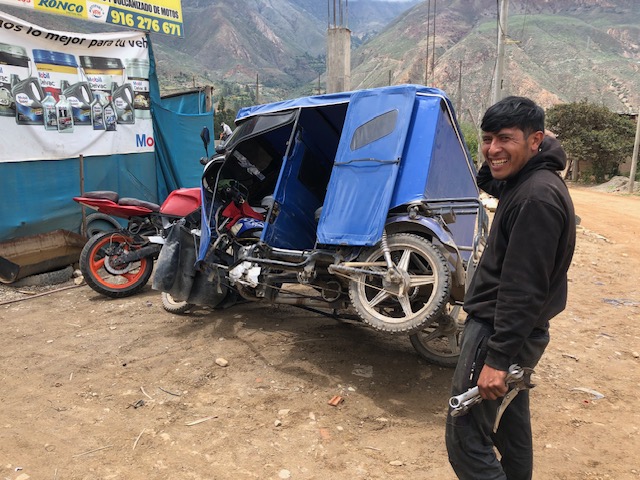
The previous night I'd started to get flu symptoms again. The few hours standing at Albert's workshop got progressively more uncomfortable. A chuck in the grass back at Casa Azule gave some temporary relief. I doubt they'd notice it.
The prospect of "camping" while crook was unappealing, so I took a cheapy hostal room in town. Maybe I should have spent a few more soles - it came without dunny paper, soap, a towel or a private bathroom, not ideal for my system's state. Kirsten's pooh stopper pills did their magic again.
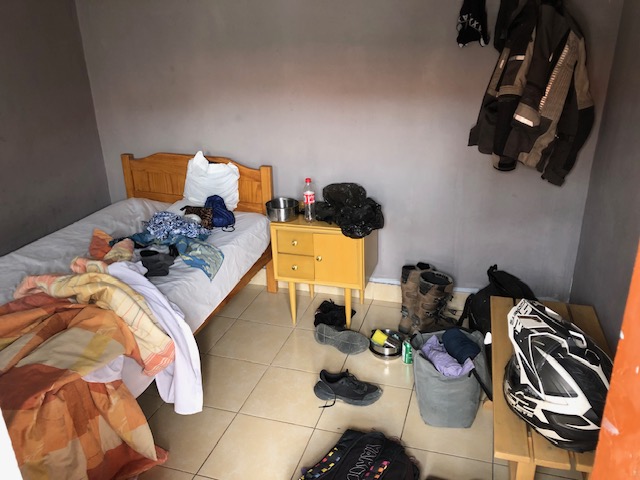
On to more pleasant topics.
The traditional dress of Peruvian ladies is brilliant. Their outfits change from region to region, but have common themes: big hats, coloured tops/shawls, long skirts with leggings underneath.
I love the hats in particular. In some towns they were all white in a wide western style.
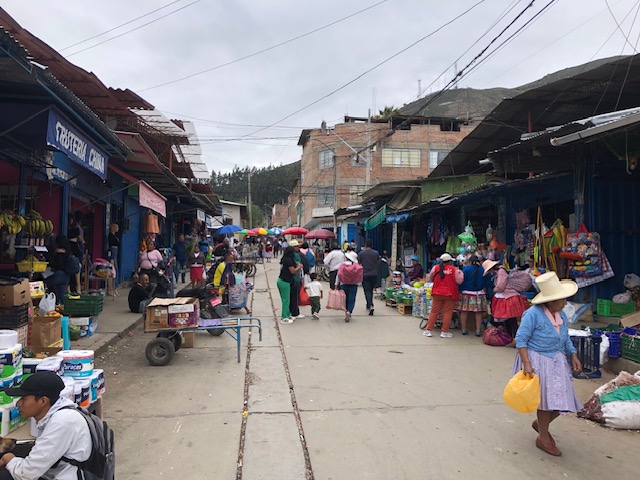
Elsewhere the centre was tall.
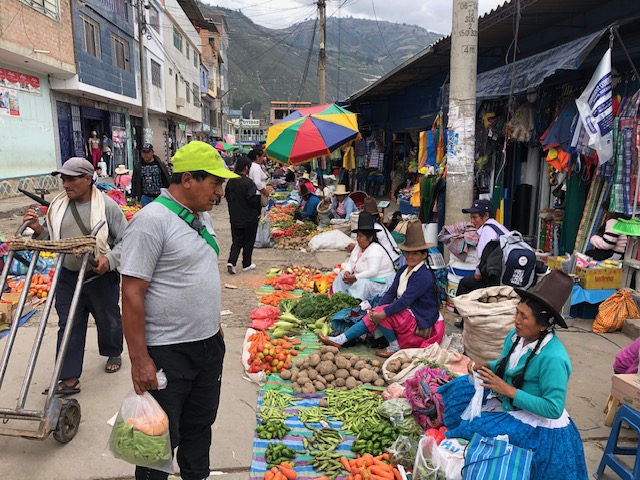
Sometimes the centre would be decorated.
The gentlemen rarely wear outfits beyond jeans, long shirt and baseball cap. This discrepancy between the genders is common across Latin America so far.
I mentioned the Huascarán National Park last time - a magnificent set of mountain peaks running north-south. I took a loop over two days, crossing the range twice. From Caraz heading east it was good condition gravel.
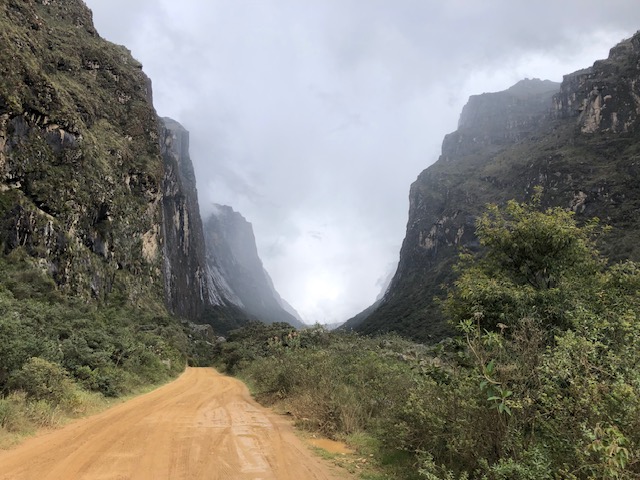
The main feature here was Lake Llanganuco, coloured the same aqua as Paron to the north. In the flesh, this hue was striking, far more than I could capture under clouds. It lay between two craggy ranges.
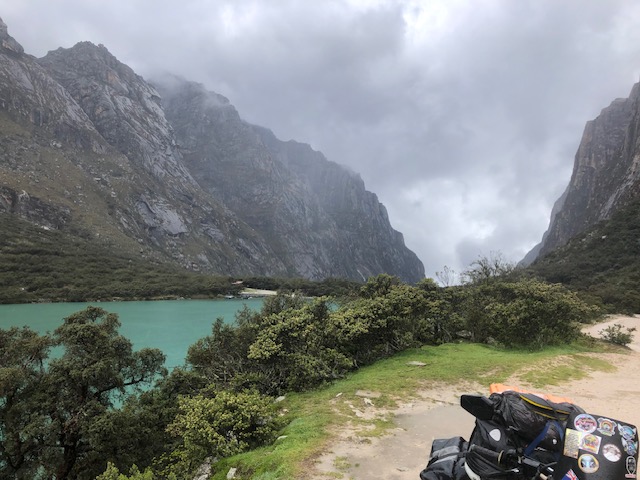
The road rose up after the lake in a set of dirt switchbacks. My golly, I stopped so many times as it got more and more impressive.
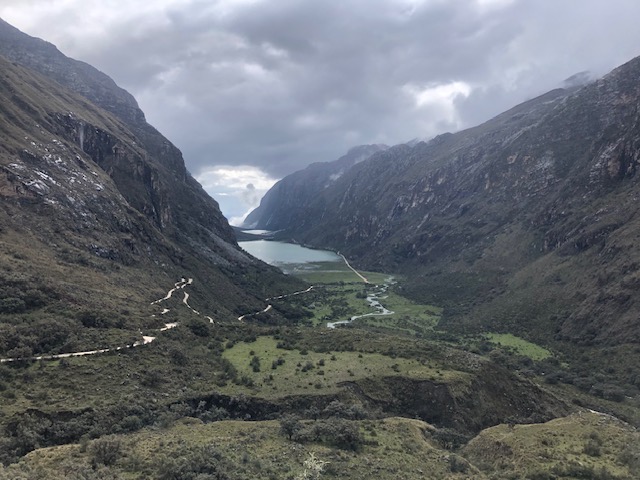
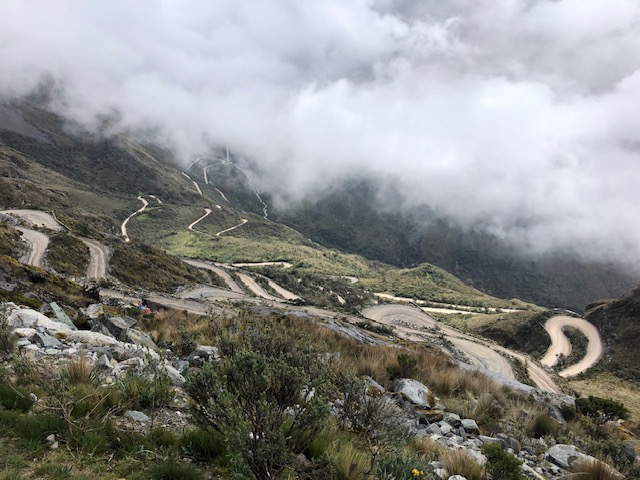
This meant leap frogging a red station wagon, us waving and tooting to each other each time. On one bend I got a bit of a wobble up, the back end kicked out over the top of the "berm" (motorcross-speak: the dirt bank on the outside of a bend) and I expected a face plant. The motorcycling gods gave a guiding hand and a split second later it was pointing straight ahead again. Phew.
My station wagon driver stopped with me just afterwards, all agog at what he'd seen right in front of him. He was a rider himself, gave me his sticker and took photos together. Happens all the time.
Yanama took the prize for the quietest town. A handful of kids played in the central plaza. Three policemen in full uniform scrolled on their phones. One restaurant was open. Otherwise ... no movement. The TV in the room was ace - haven't watched a CRT for decades, but at least there was some neat programming.
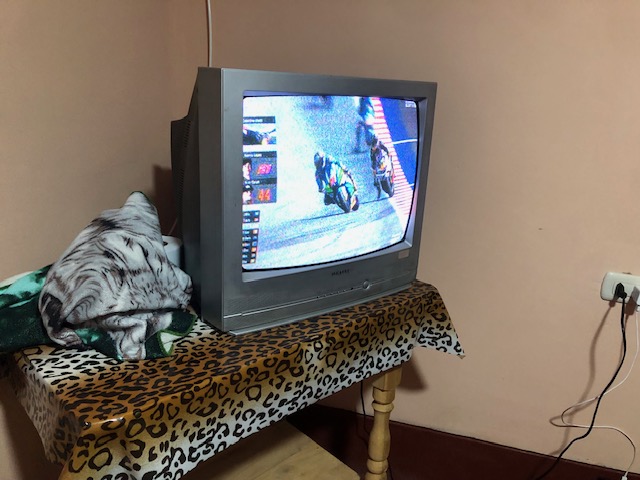
Continuing the loop next day started with farmland and minor rural roads, sometimes quite rough, sometimes slushy, sometimes fast dirt. It must be tough on such small communities in these winter times.
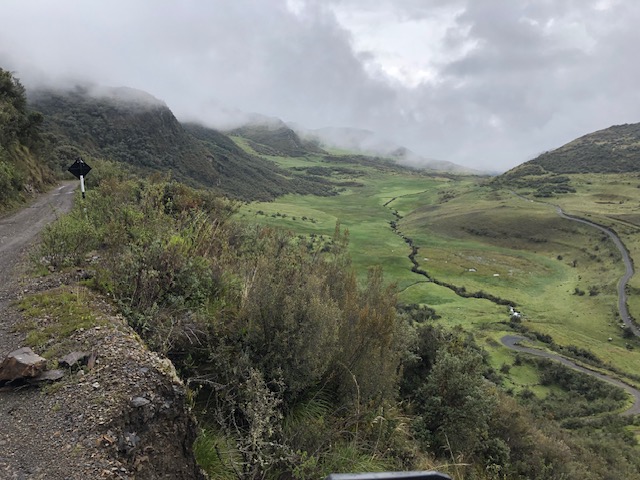
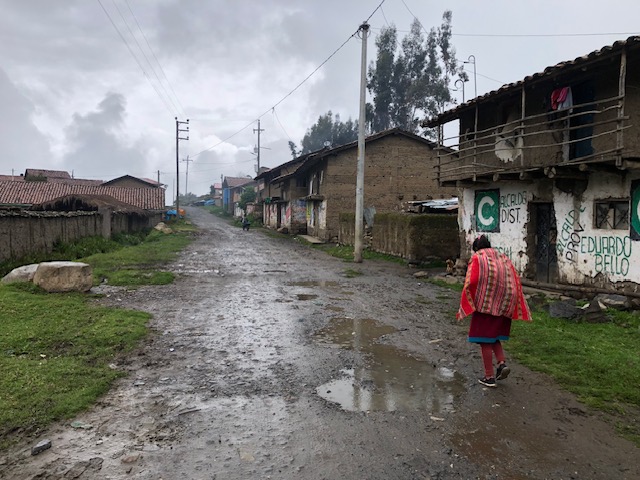
By Chacas it was all easy tar, heading westward back across the park. Punta Olimpica has a long tunnel through the mountain. It starts at 4680m and heads dead straight for 1.4km up to 4739m.
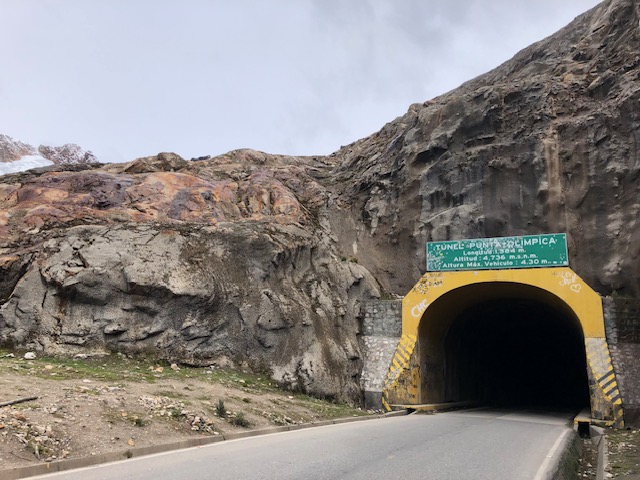
Yes, dead straight - the dazzling white snow at the other end was visible the whole way. It "rained" in the tunnel, more than it had for a couple of hours outside.
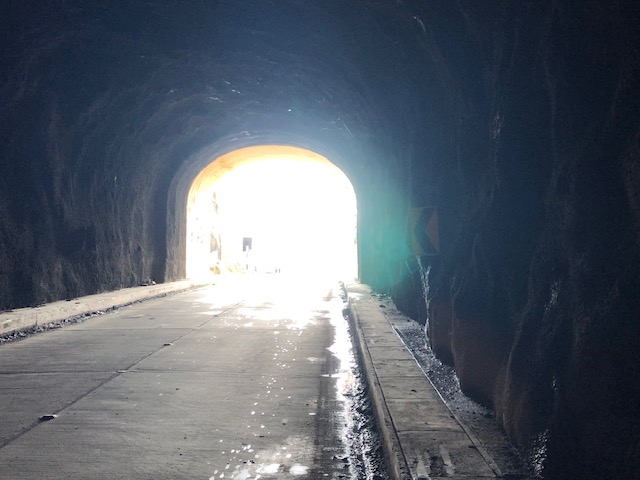
What a view upon emerging. I *think* we're looking at Chopicalqui here, if not it's Huscarán, Peru's highest peak. Maybe even both. I dunno.
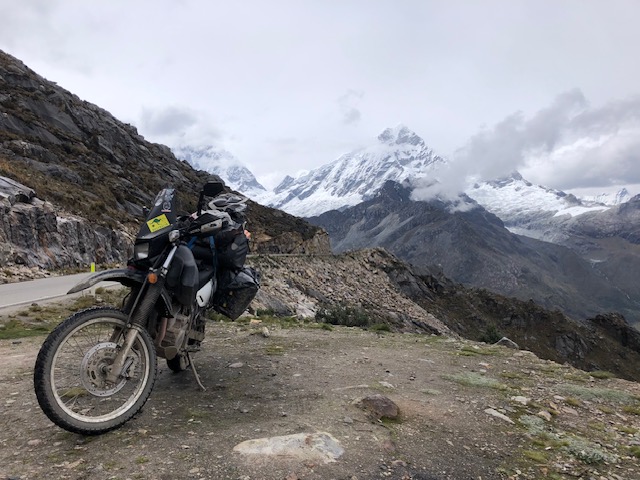
Certain scenes trigger a Pavlovian response to take photos: a waterfall, bridge over a river, snowy peaks and looking down on switchbacks. 25 hairpin bends take one down to the valley floor.
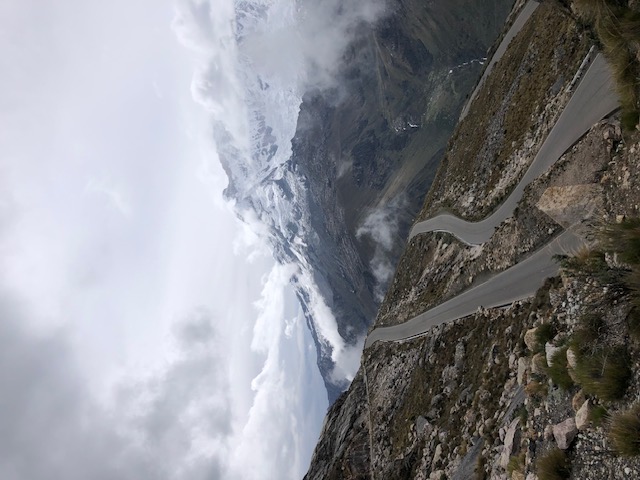
On one bend a quartet of dancers were being filmed. Even with the insulation of their traditional Latin ladies build, these two must have felt the cold on their mini skirt wearing legs. Mind you, they were vigorous.
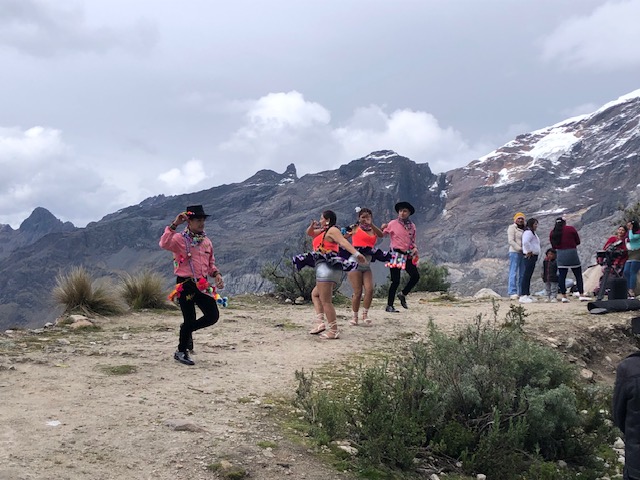
The fabulous four Colombian friends were also staying in Huaraz, so I joined them for the night. Peru has a multitude of "Chifa" restaurants, offering a mix of Chinese and local dishes. Their "chaufa" (fried rice) is hard to beat for value. We got fat on huge portions.
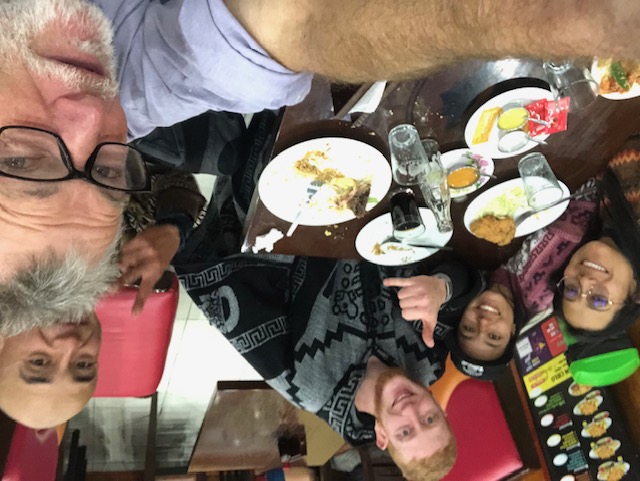
Next morning the quartet were saddled up and ready to roll early. With only a month in hand, they'd gone as far south as time allowed. They were going to the coast before turning north for home in Medellin. But would we like a coffee together before splitting? Sure!
This led to a odd but interesting interaction. A shop about the size of our kitchen was in the front of a lady's house. She sold toys, sweets, beer, liquor, wine, stationery and other unrelated items.
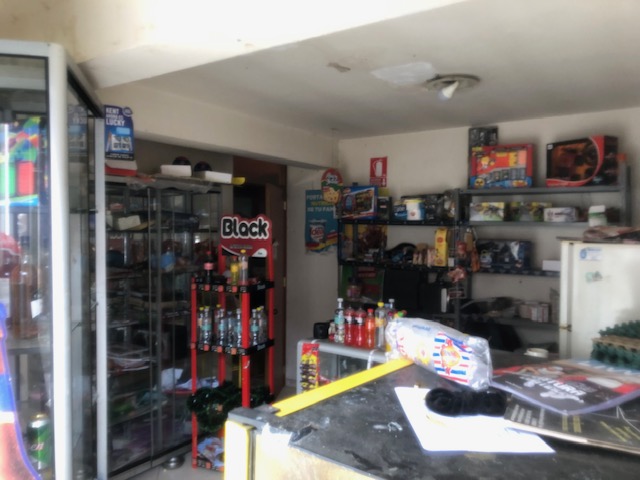
Camilo asked if she could make five coffees. Yes, she could. Somehow, it morphed into her cooking fried egg rolls, surprising Camilo as well.
We (well, they) had a long chat with the lady, covering family and things and stuff. It was all hugely friendly. In the end, we left and I asked Camilo about paying. No, she didn't want payment. It was generous, odd and uncomfortable all at once.
My cheap-arsed runners were apparently not designed by Kmart Australia for Peruvian conditions and had fallen apart. Shopping for a replacement pair was fun.
Latin American commerce has one big theme: folk selling the same goods always band together. They also have identical appearances. How on earth do they all make a peso/quetzal/limpera/colón/córdoba/lempira/sol/balboa/dollar?
Random eg #1 Fruit stands in any given town will have produce arranged in the same pattern. If they are waving flags for attention, the flags will all be the same.
One roadway in Costa Rica sticks in the memory as twenty or so women were all selling fruit, waving hands to passersby, each dressed in skin tight clothing, midriffs showing. Their figues varied.
Random eg #2 A block in Mexico City was chockers with washing machine part stores. Next block was all electronic components stores, and so on.
Anyway, back to footwear.
A block in Huaraz was all shoe shops.
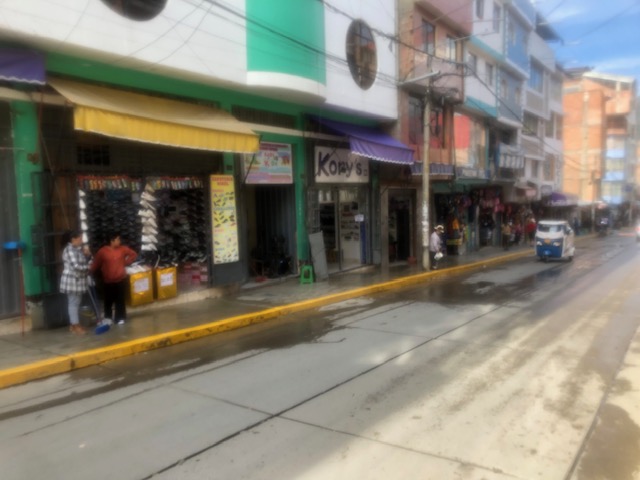
I walked into one at random and the proprietor shook her head saying "43" as she pointed to my feet. She indicated across the road to a competitor who 1) looked the same and 2) didn't have my size either.
For sure local men are on average of a shorter stature ... and just remember folks, everything is in proportion ...
Directions were given to another part of town, which I followed without success.
By and by a store with mostly fancy looking ladies fashion had an odd pair to fit. Hooray.
Huaraz has been described as Peru's most beautiful city. Yeah, nah. However, it does have some incredible backdrops. Imagine looking up from all the maelstrom to see some of the country's highest peaks.
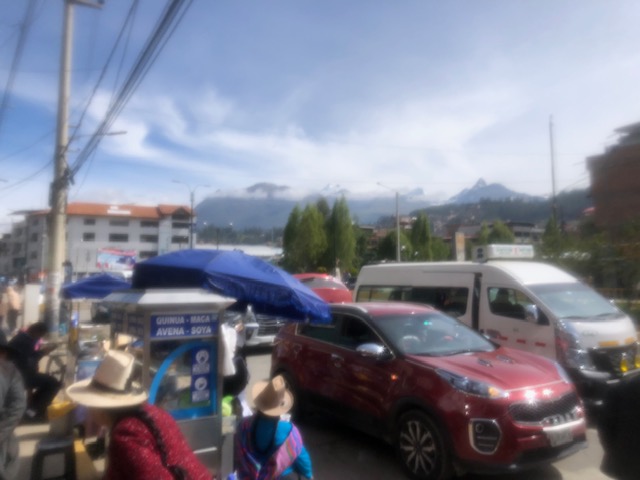
Turning east off the main highway near Catac was immediately relaxing. Goodbye trucks, farewell clouds of diesel and dust, so long threatening traffic. Fast smooth gravel cut through a wide open valley.
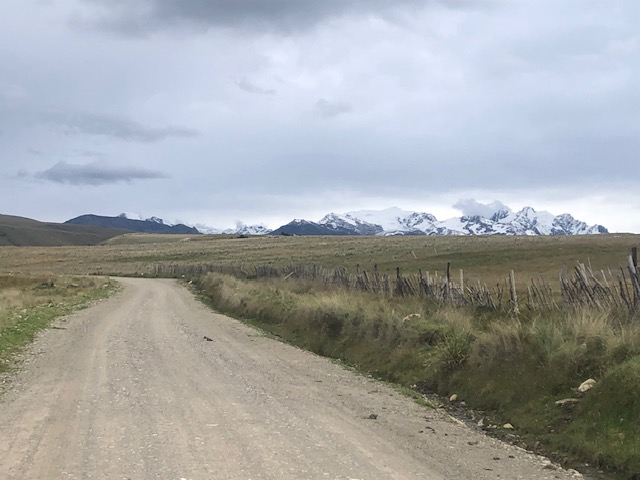
Cattle and horses were scattered without fencing. Isolated huts were off in the distance.
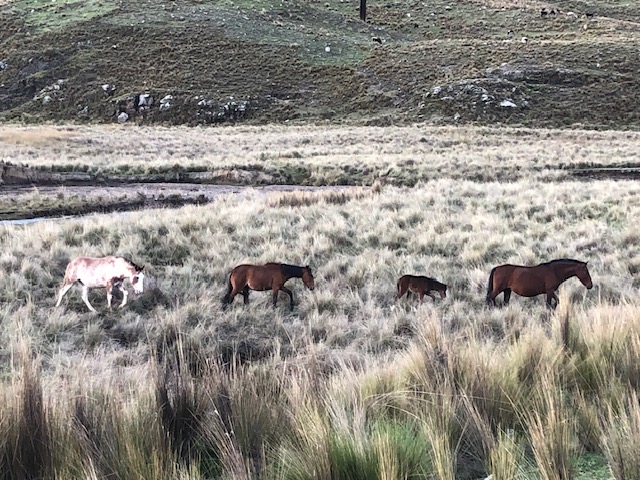
These unusual plants are Puya Raimondi, "The Queen of the Andes".
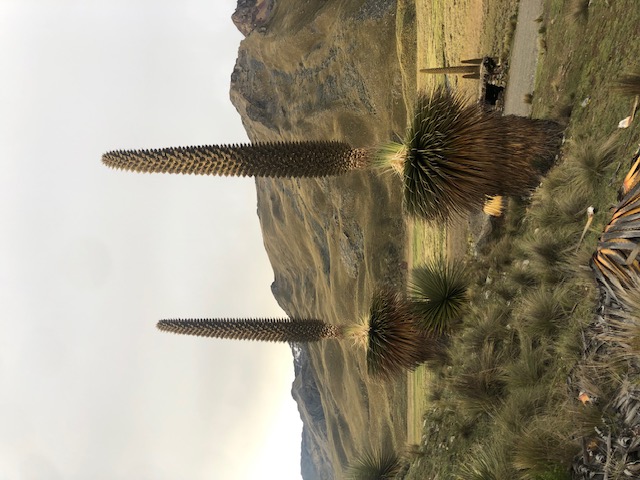
They grow up to 15m when flowering and once their seeds are ripe, after 40 to 100 years, the entire plant dies off.
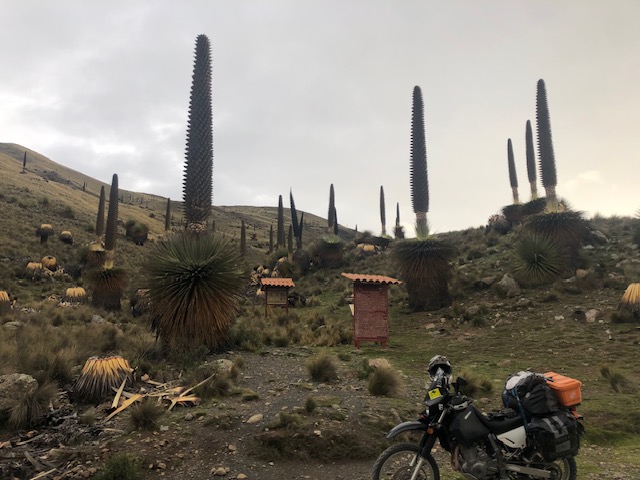
Close by this stand was a natural pool on the valley floor. It appeared to be several metres deep. A viewing platform became a top little campspot.
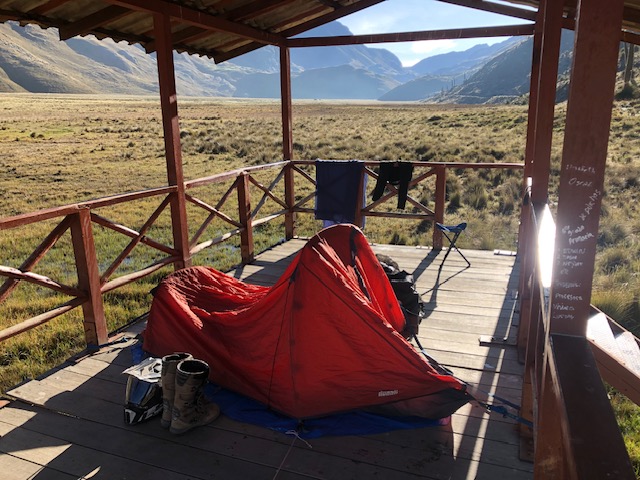
I trundled the bike down a cobblestone path to the platform, realising too late that the path became chunky steps. A turn around spot wan't obvious, but that was a problem for tomorrow morning Gavin.
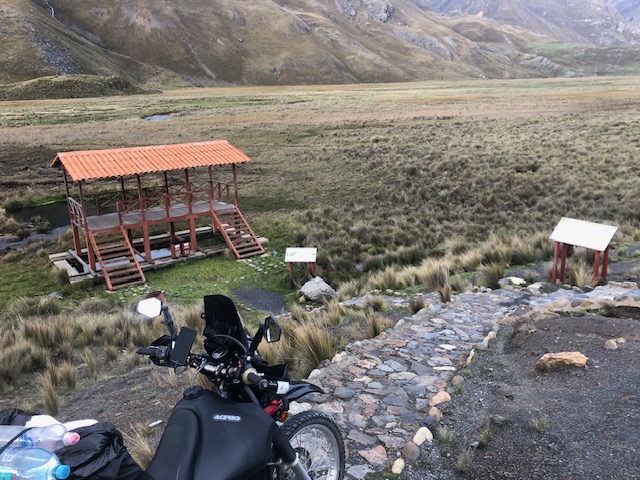
What a peaceful night. The first without human sounds since maybe camping in Mexico. Just white noise in the distance from wind. That beautiful Southern Cross was just over the horizon - a first sighting after many months.
You'd think this would make for great sleep, but alas the cold and perhaps too many nights in a hotel room had me tossing and turning. It didn't matter. I was deliriously happy being out alone.
The morning was glorious.
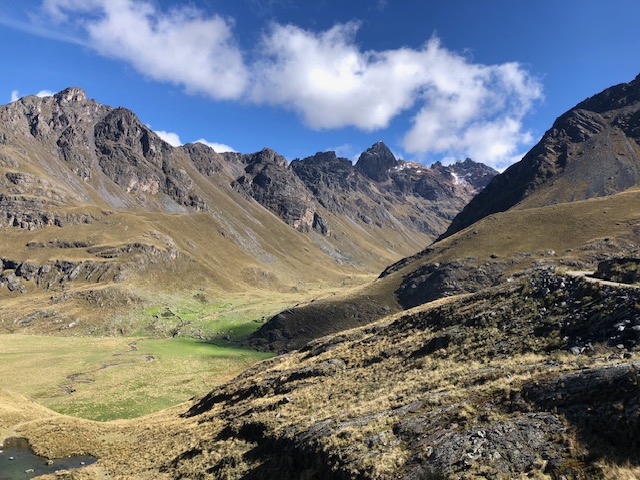
The question of how to turn the bike around without marring surrounding terrain resolved itself when I stupidly put it into neutral, walked away and the bastard rolled off the side stand then fell over the edge of the path. Oh crikey ... again?
It was sort of upside down, tyres in the air, petrol pissing from the cap. The fix was to twist it on the pannier until the tyres were vaguely downhill, then grunt swear and lift.
The panniers are both pretty sad now. Repairs to one side are coming adrift, so a ratchet strap has become a backup. Ugly but effective, like some of my co-workers in recent years. They only need to last a few more months travelling then take my junk back home.
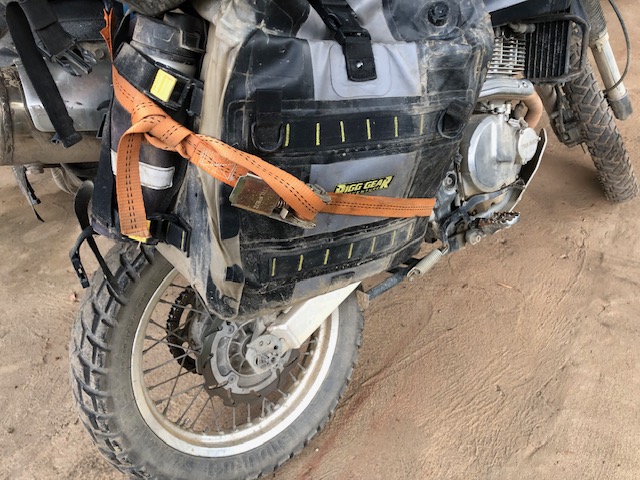
Passing locals offered sympathies.
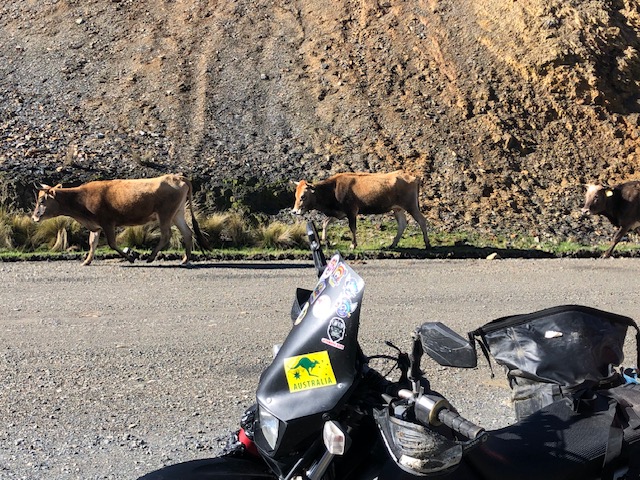
No humans in sight, the moo moos were just doing their own thing.
Pastoruri Glacier was the reason for taking this path. A short ride up pretty hills lead to the start of the walk to the glacier. It's at 5000m, a new PB. Much is made of altitude sickness hereabouts, coco leaves being suggested as a preventative. I was intrigued, so took a mug of coco leaf tea from this lady. Quite yummy, actually.
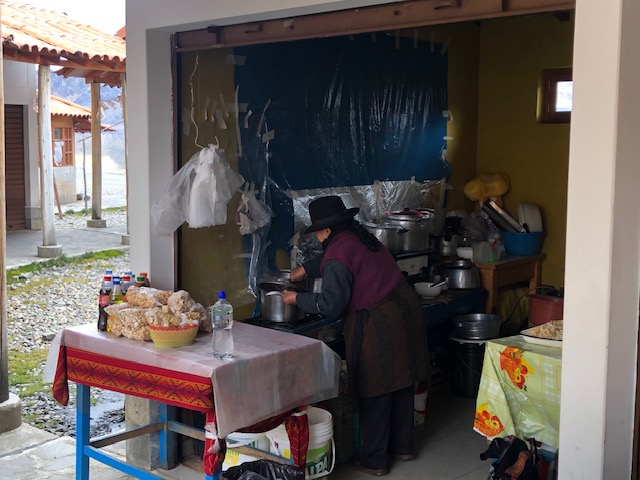
The 2.5km walk was straightforward, though rather cold and breathy in the rarified air. One could hire four legged transport. Ah, let them relax and chomp their feed before the tourists arrive.
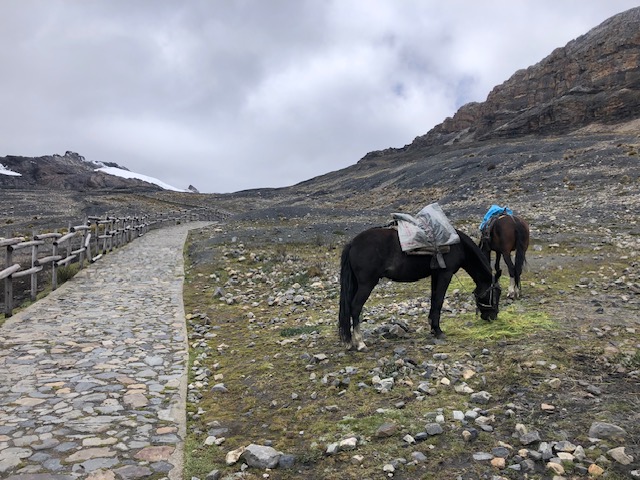
Pastoruri is receding by 15m each year. Too many selfish arseholes burning dead dinosaurs flying and riding around the world.
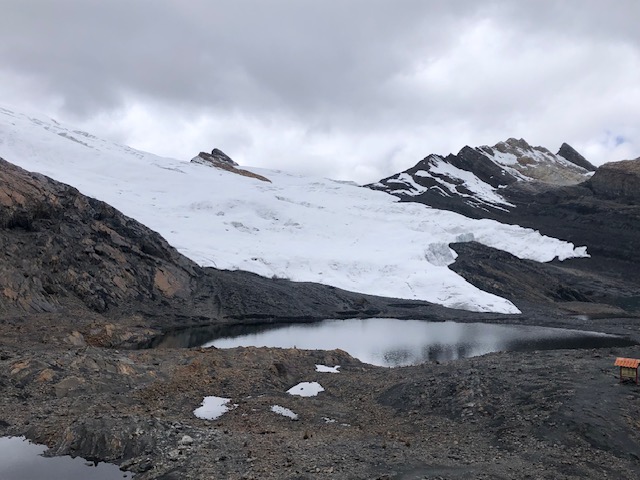
After seeing glaciers in NZ, I found the ice only mildly interesting, but the surrounding scenery was captivating. It sure was nice being alone in all of it, before others arrived.
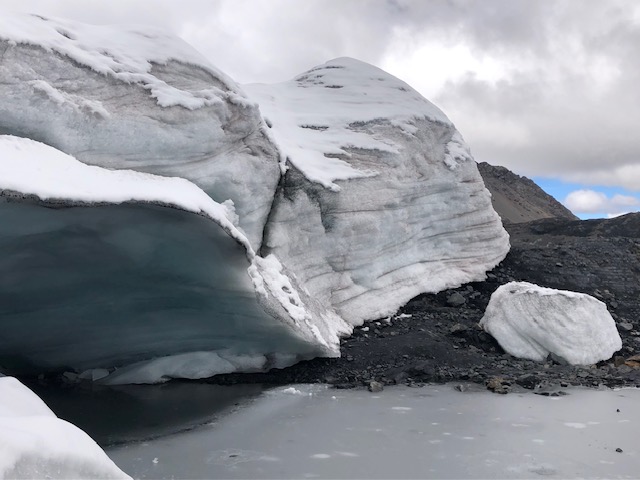
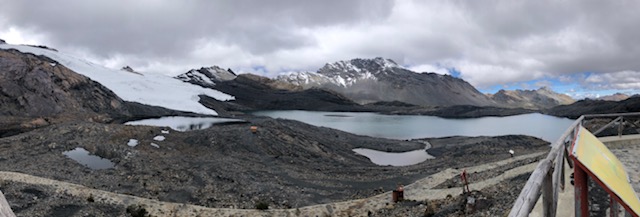
A family from Trujillo had come on horses. The bloke was curious, wanting photos together. It was puzzling. I was just a single bloke walking, no motorcycle in sight.
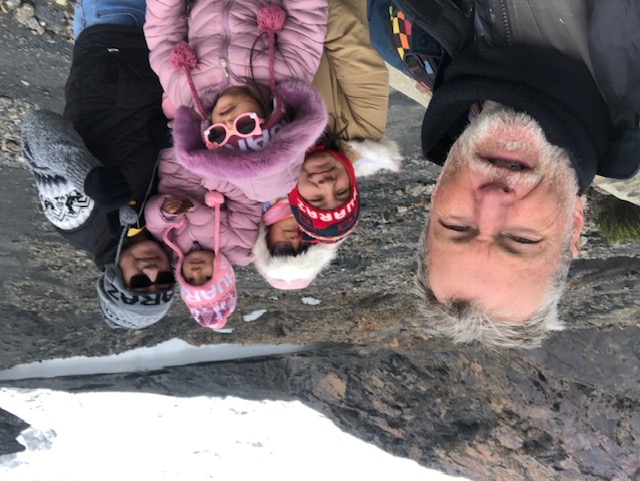
A rock face had fossils. The only one I could discern was this frond.
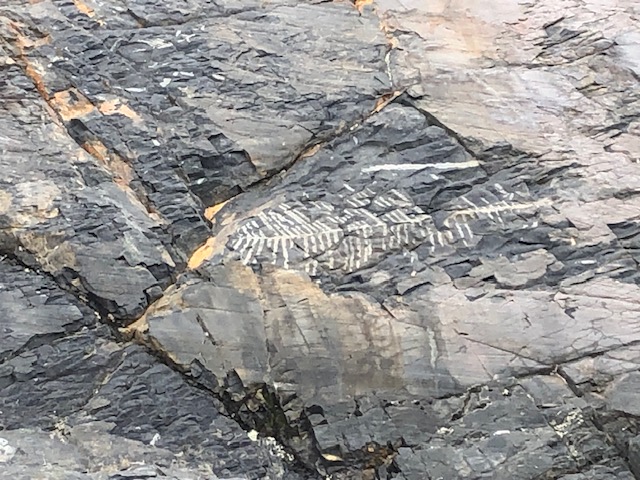
The hordes had arrived by the time I returned to the start. There was a roaring trade on plastic ponchoes, beanies and the like. Made sense - I'd worn all of my riding gear apart from helmet and boots to ward off the chill.
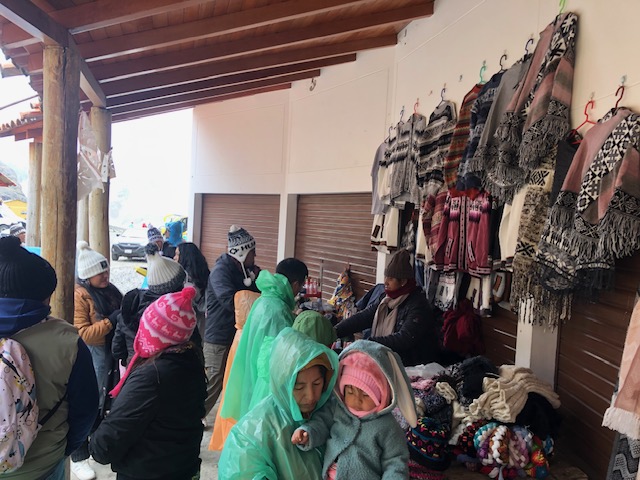
Most visitors come in buses via the same well maintained gravel road. Continuing east after the glacier was obviously the less travelled path. It was all second gear, dodging puddles and rocks in the rain. Slow but involving with expansive views. Once again, perfect for the DR.
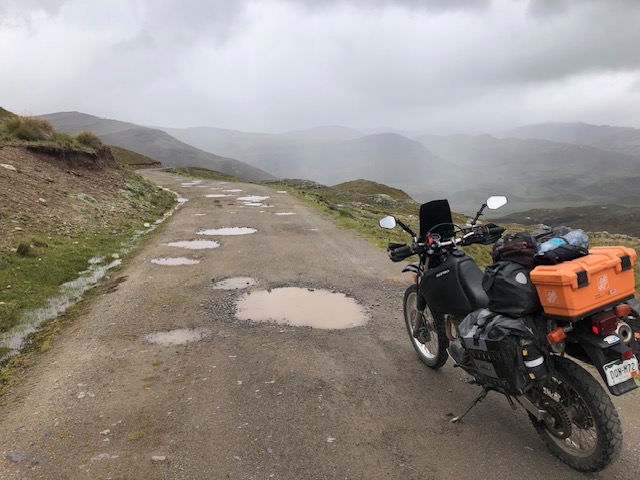
Beyond the national park, it varied from excellent asphalt to downright crappy slush.
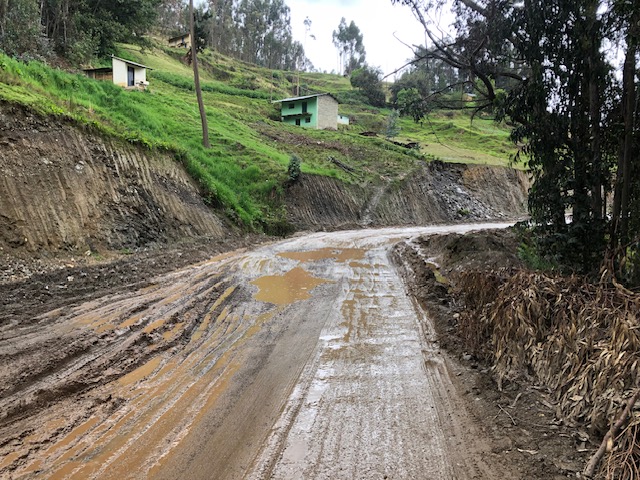
Obviously a heap of effort and money has been put into the road network. Big sections of earth have been shifted. Curiously there were maybe fifty stretches of new tar with bedrock in between. Some tar sections were 2km long, others only 2 bends long. So the riding oscillated between zooming along and bumping up and down on the pegs.
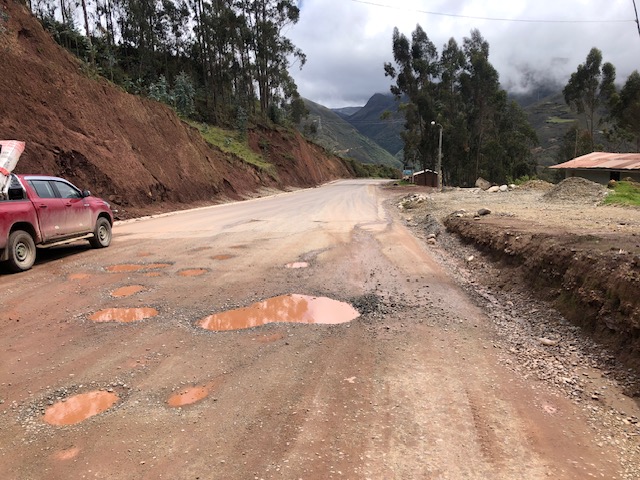
Peru is one big archeological site. Blue signs everywhere point to prehispanic ruins. For curiosity I stopped at Nunash, a somewhat random choice, knowing nothing about it. Ruins of stone buildings and walls were spread over dozens of acres. No signage meant I couldn't properly appreciate their significance. Good on the Peruvians for retaining their heritage.
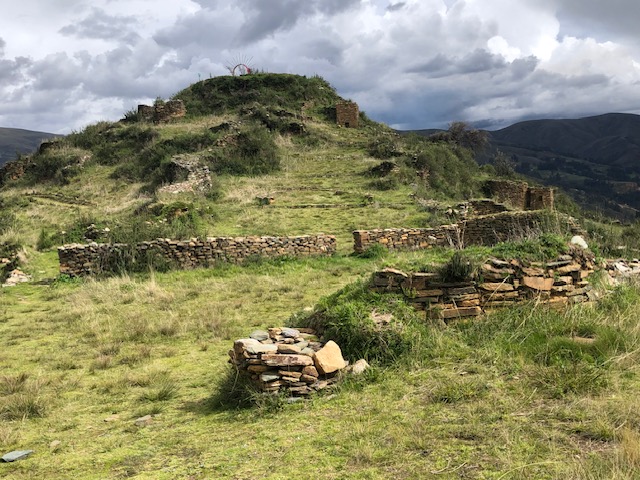
Chavanillo was a disappointment that night. A well reviewed hotel was overpriced, no restaurants were open on a Saturday night and the streets were awash with mud.
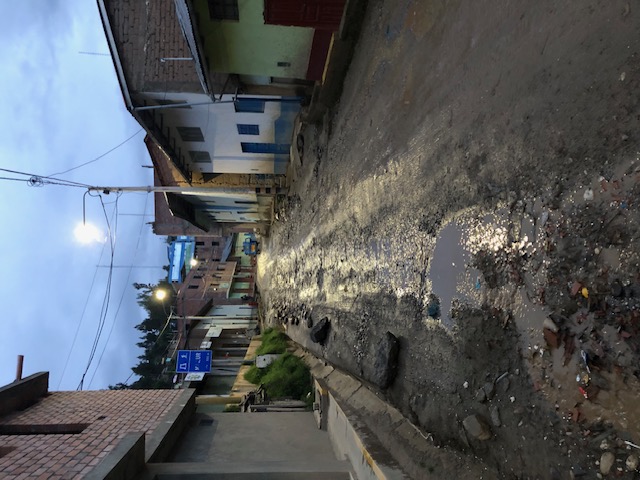
Dinner was ten banana sandwiches in bed for a grumpy old man.
Come sunrise things always seem better. Chavanillo locals were certainly relaxed.
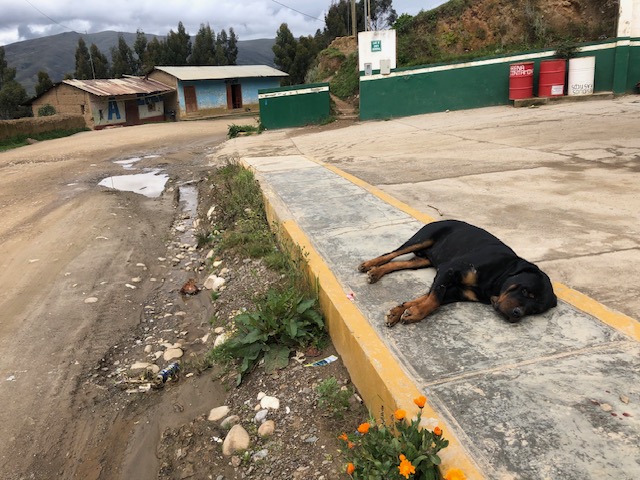
South of Huancayo were rolling hills that were easy on the eye.
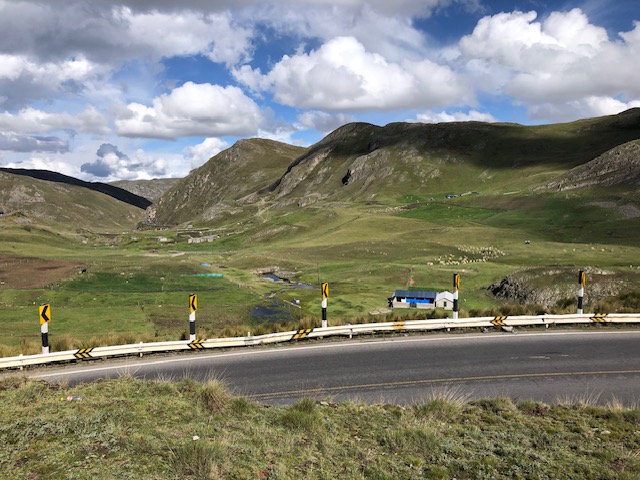
Newer tar had been laid on top of a broader lower layer. This top layer was so thin that most of it was breaking up. It was smoothest flying along on the old layer, on the very edge of the road. This called for high focus.
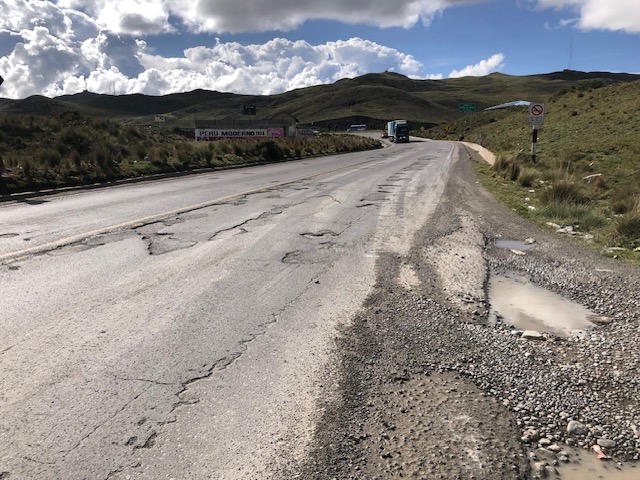
Lake Chinchaycocha boasts numerous water birds including flamingos. These creatures didn't support photographic efforts, so you'll have to squint a bit.
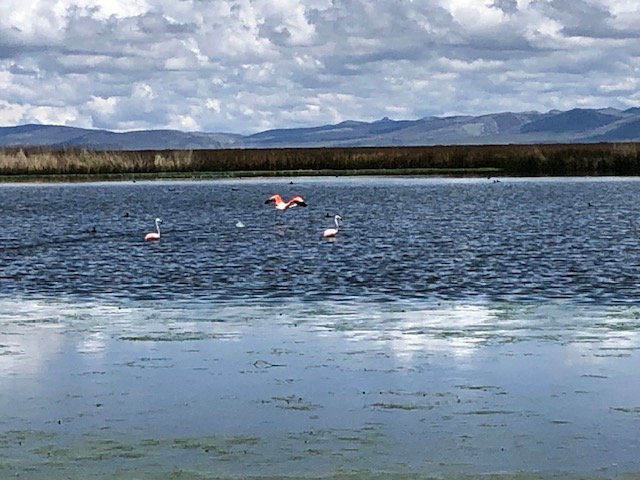
Easier to record were alpacas and llamas. How do they differ? Apparently alpacas are smaĺler, have squashed up faces, are easier to deal with and boast superior wool. I believe this is one.
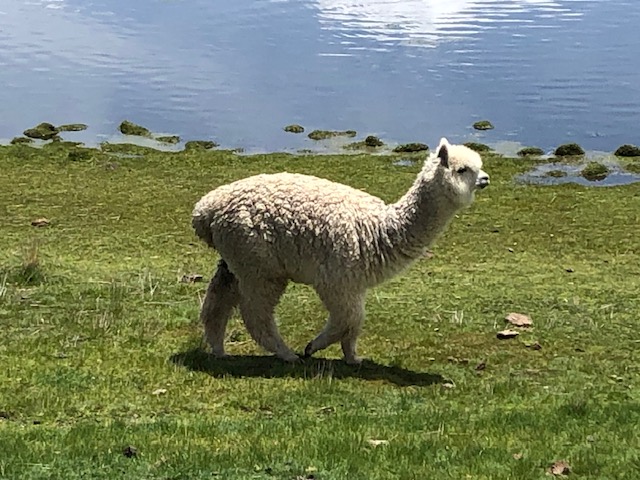
and this the larger, coarser llama.
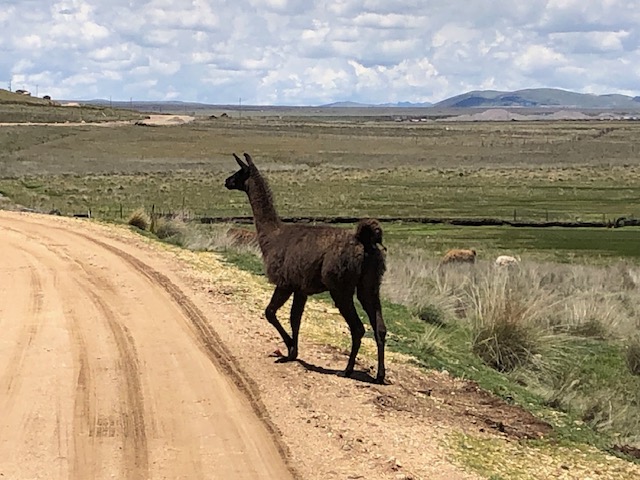
The lap around the lake took about 100km and two hours. It was enjoyable being on long quiet dirt roads, stopping now and then to soak it all up. Right up my alley.
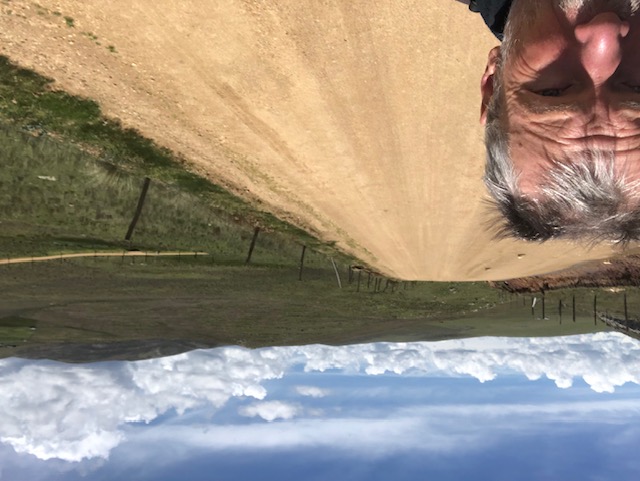
Contining south of Junin was more open rolling countryside. It morphed into layered rocks in a canyon, such as in the mining town of La Oroya.
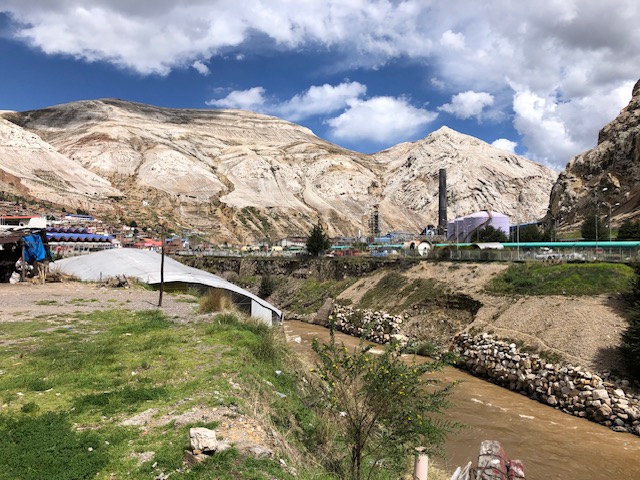
The city of Huancayo was an overnight stop chosen mostly for convenient distance. This is really not the best strategy. It would be better to aim for a more peaceful locale even if plus/minus a few kilometres. Entering Huancayo was rubbish - non stop horns, aggressive use of space and an awful change from the open road.
The only light relief was chuckling at this sign. What smartarse comment could go with it?
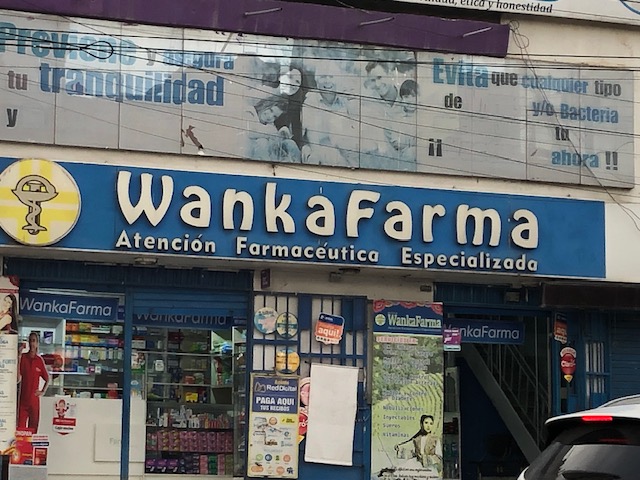
Turns out that the "Wanka" are an indigenous people in this area and even give rise to the city name "Huancayo". The name is everywhere: the Restaurant Turistico Wanka Wanka (repetition not a mistake), Hotel Wanka Palace and so on.
No smartarse comments then.
Once riding is stopped for the day and walking takes over, the cities are often more palatable. Bunches of kids danced to boom boxes in a plaza.
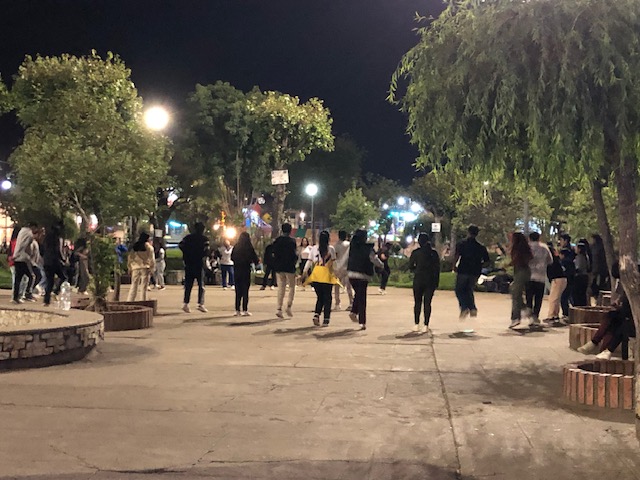
Dinner was a quite plain pizza from a cute wood fired oven on wheels.
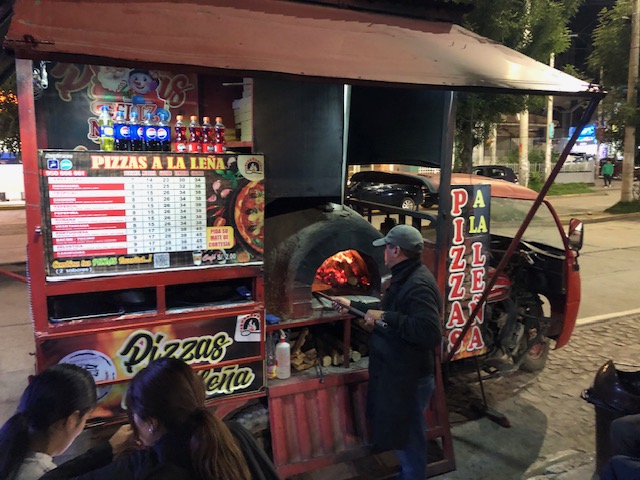
The day between Huancayo and Ayacucho had an intensity to it. It started easily enough, cruising through a crop filled valley.
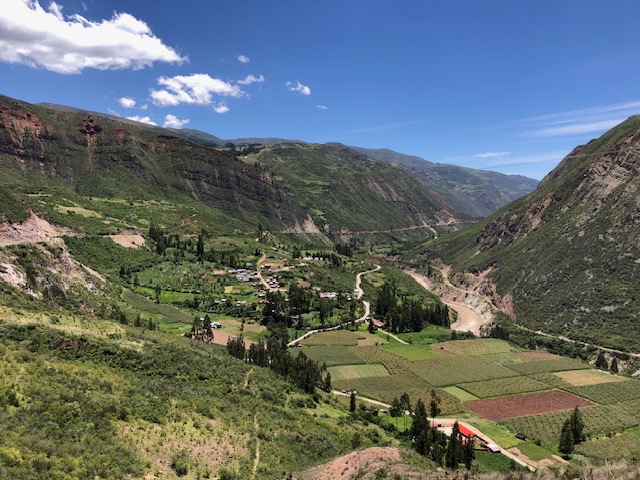
After Izcuchaca it become a long, narrow and twisty run above a river. The surface was notionally tar, but it kept breaking up or dissappearing altogether. It was the dustiest day so far.
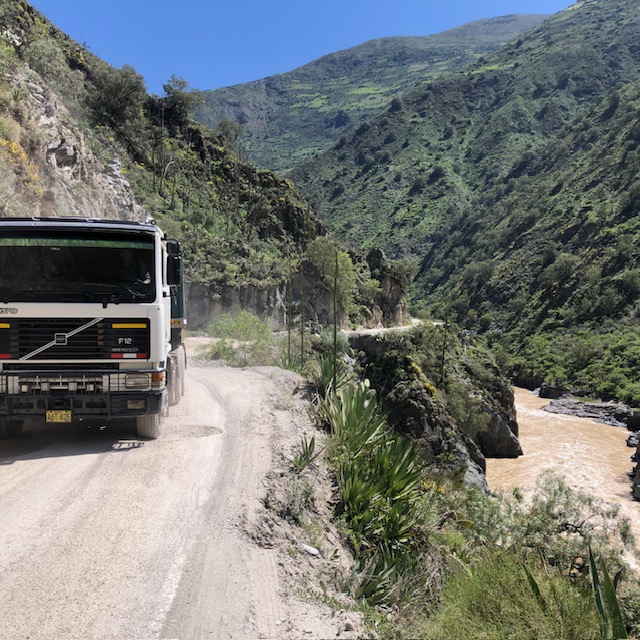
Fortunately the bush pig handles this well and being a single tracker its easy to pick a smooth line between the damaged parts.
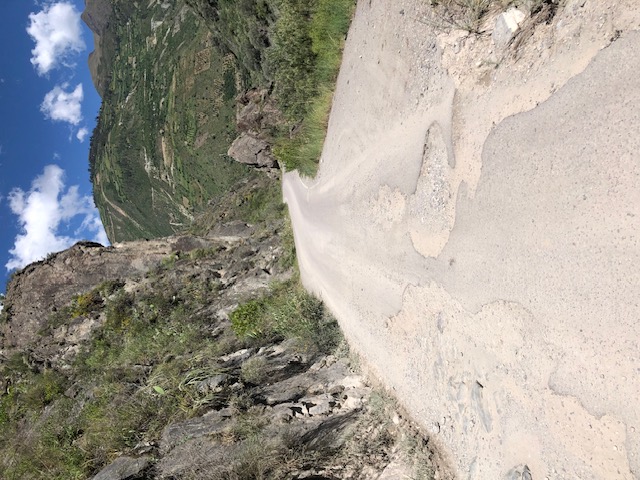
Later it became desert like with varied cactii, rocks and yellow sands.
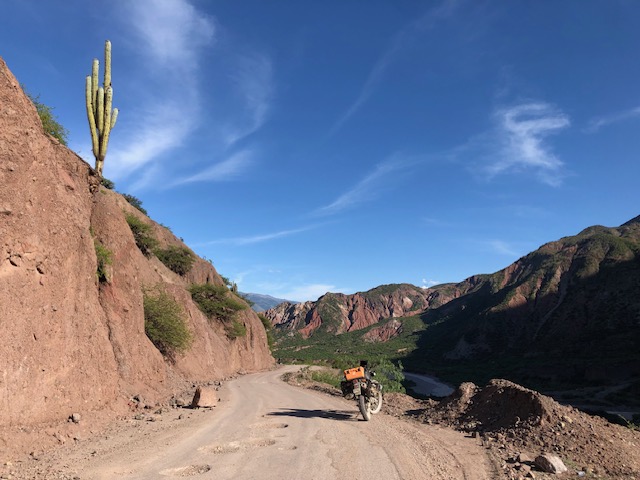
One fellow's car was running on the space saver spare wheel, but with zero air pressure, the tyre bead completely separated from the rim. Did I have a pump to help? Well yes, but it's a pushbike pump. After maybe twenty strokes he felt the tyre. Nup, still not inflated. He gave up, wrenching the pump off. Now the pump doesn't seal too well on a valve stem. Grrr.
For a city Ayacucho was nice. Perhaps such a feeling points more to a state of mind than anything else. Perhaps it was being reminiscent of many Mexican "magico pueblos" with their colourful historic central areas. Perhaps it's finding a yummy latte ... at a gringo price.
Regardless of why, a morning was well spent: walking to a city lookout, then wandering semi aimlessly just taking it all in.
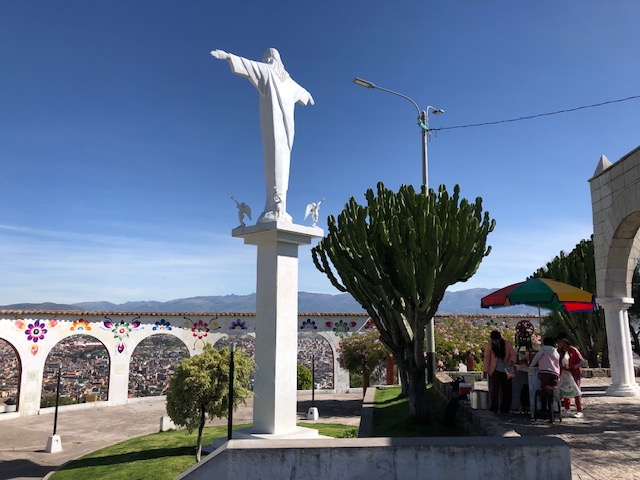
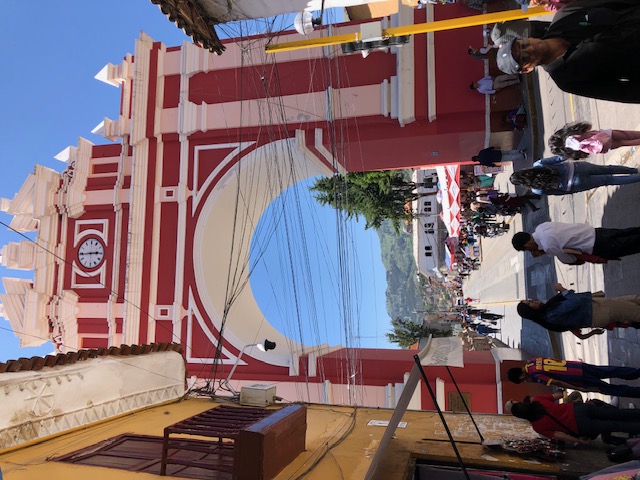
Must be handy for the residents having an airport in the city.
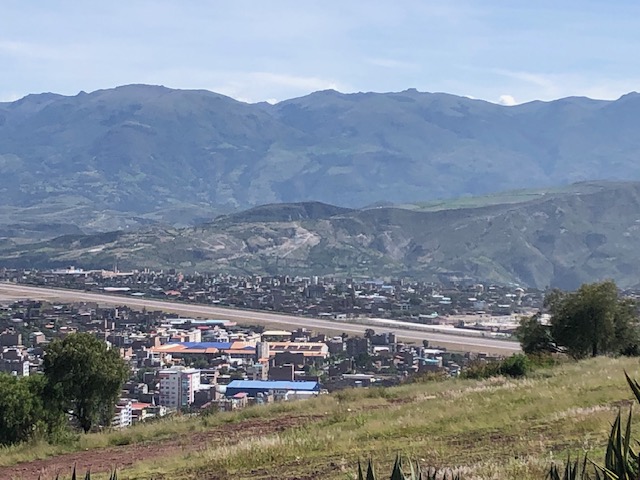
Exiting Ayacucho was weird though, thanks to Mr Google. For reasons unknown, he first sent me up a skinny steep lane ...
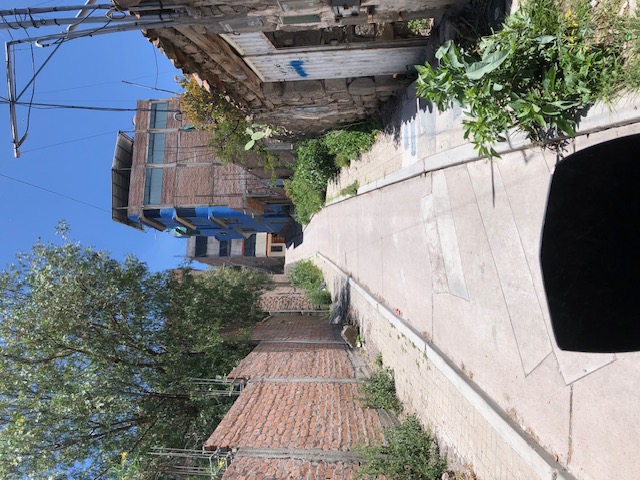
... then via the scungiest dirt possible, instead of a major tar highway. Huh?
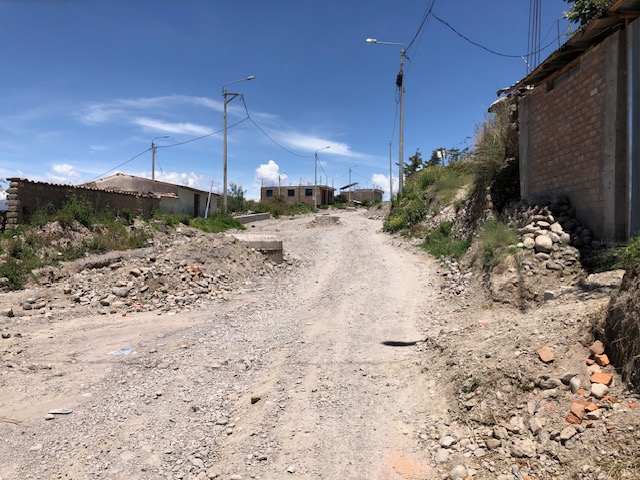
I considered another bike wash, but the adverised staff weren't working that day.
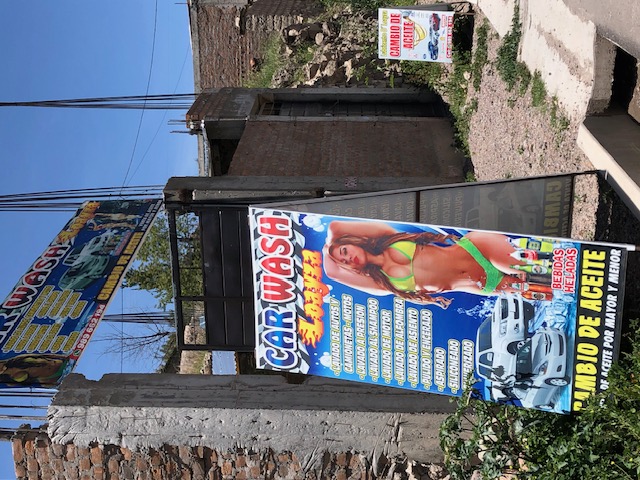
I loved the plains beyond Ayacucho - 80km of gorgeous high altitude countryside, just grasses and shrubs no higher than your knee. Chilly but oh so pretty.
In the time spent at this spot, having a pee, a drink and an apple only a handful of vehicles passed. For once the only signs of humans were the road itself and a power line.
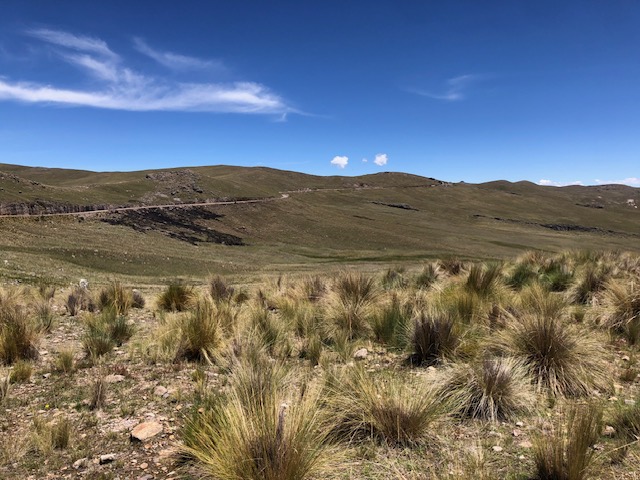
Nearly all the riding in Peru has been uplifting. I won't describe every bit - it's too hard finding new superlatives.
Overall, I'm content with how the bike is now. The stalling hasn't reappeared. It's obviously low on power and sometimes lurches a bit with altitude, but not enough to worry. It's still very usable.
The chain is still clanging and banging at low speeds. I can't adjust it up as it's got a tight spot where it has the minimum permissable slack. It's in palliative care. A new chain and sprocket set is on its way to Cusco, as am I. The trick is that Peru customs is notorious for holding up shipments for weeks. Patience Gavin.
Yesterday a particularly intense blast up the twisties away from Abancay had me doing Mark Marquez impressions. Well, it felt like it, scraping side stand and boots.
Once at the top, the small village of Cachora came into view, dwarfed by mountains.
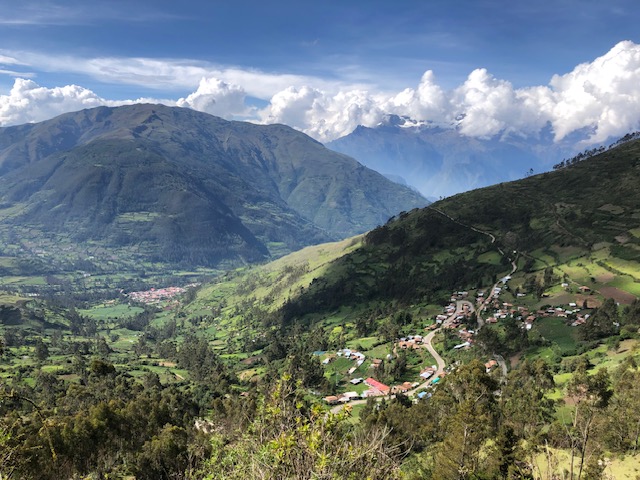
On my first night in Costa Rica, some four months ago, I chatted with a Canadian lady working at the hotel. She spoke of a three day hike to Incan site Choquequirao, sister city of Maccu Pichu. It appealed because where Maccu Pichu gets 5,600 visitors a day in high season, Choquequirao gets twenty. No bus, in fact no roads. Walk or mule ride in.
Cachora is the gateway for the hike. Looking out from luxury digs, Choquequirao is out there in those mountains.
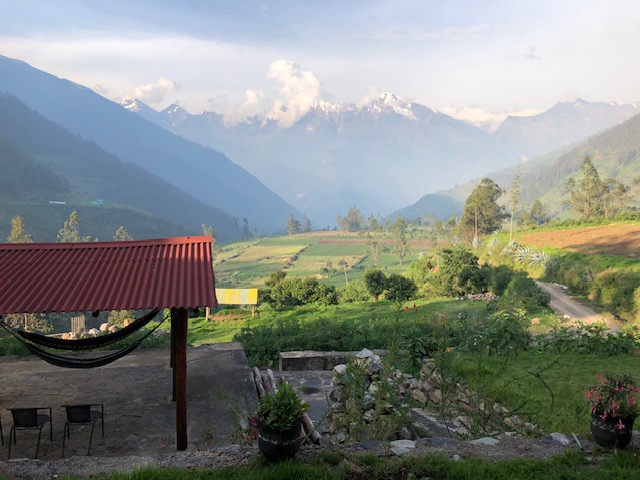
Roll on tomorow.

